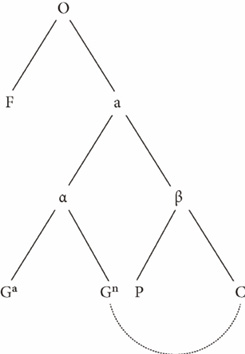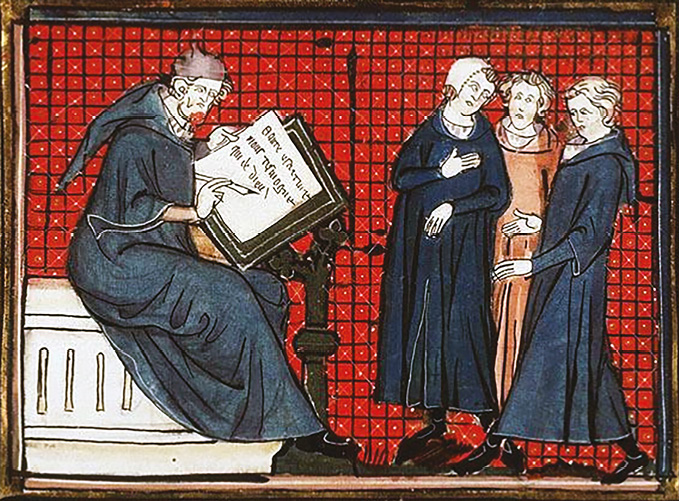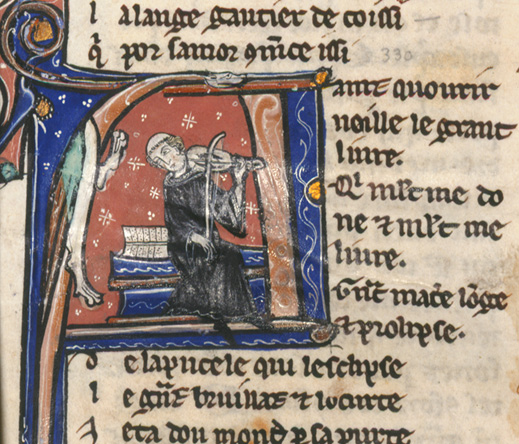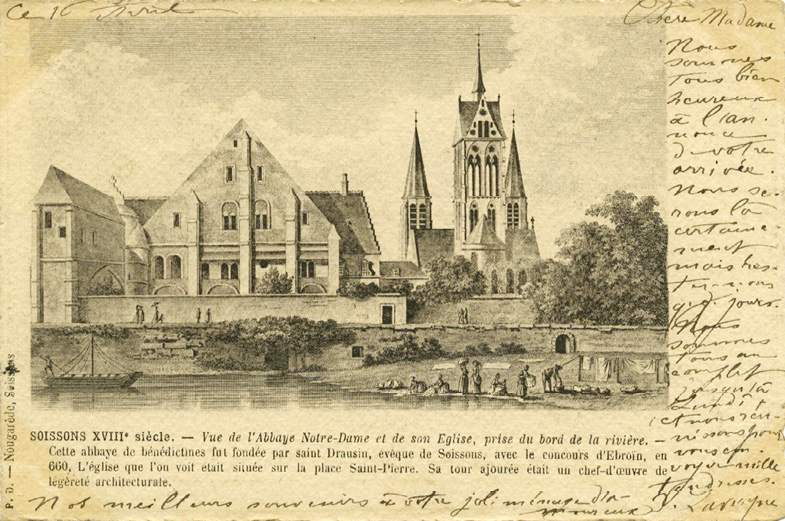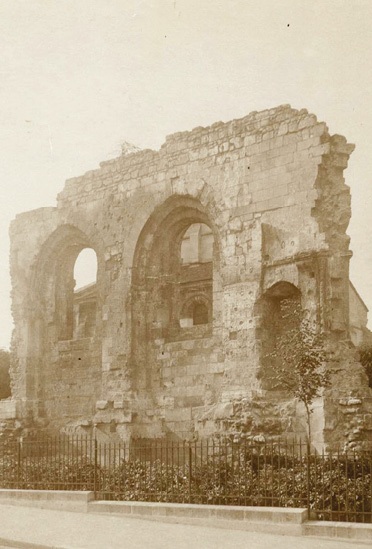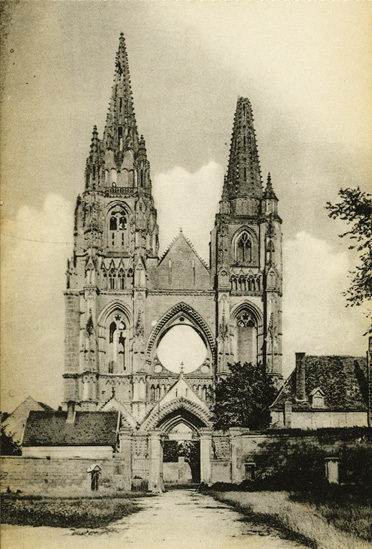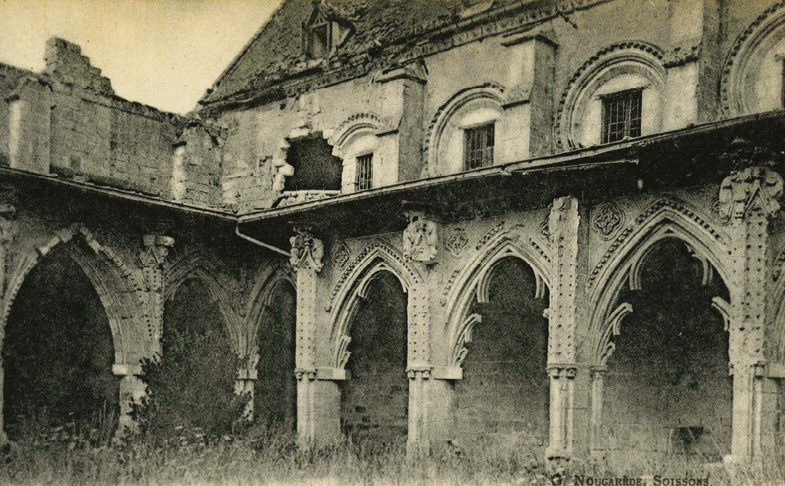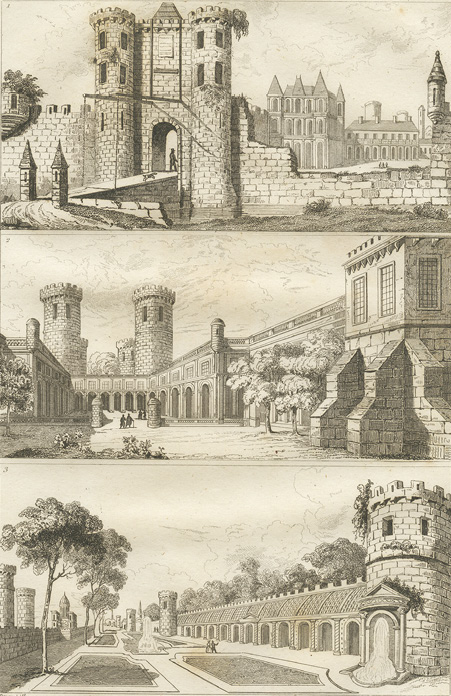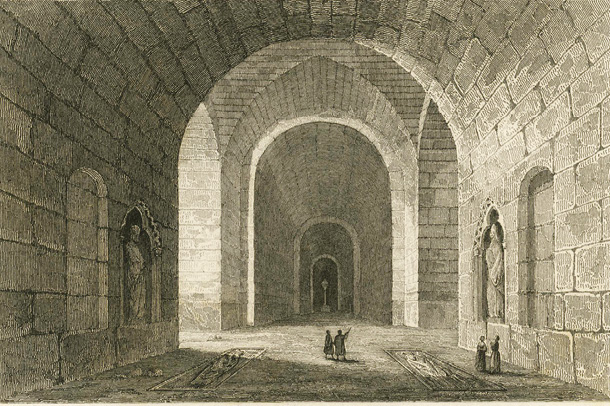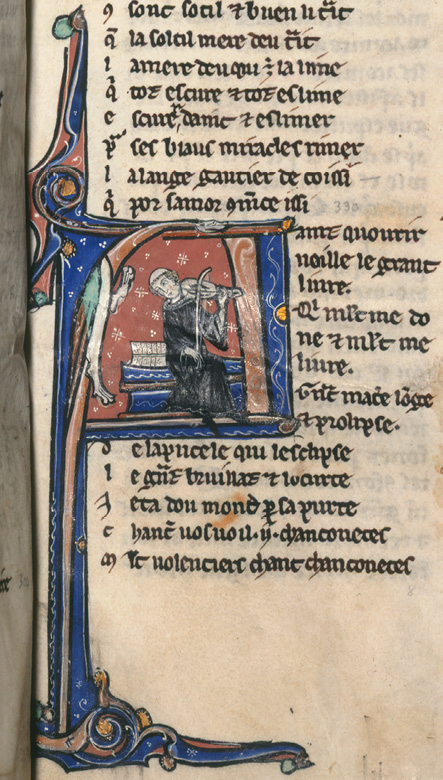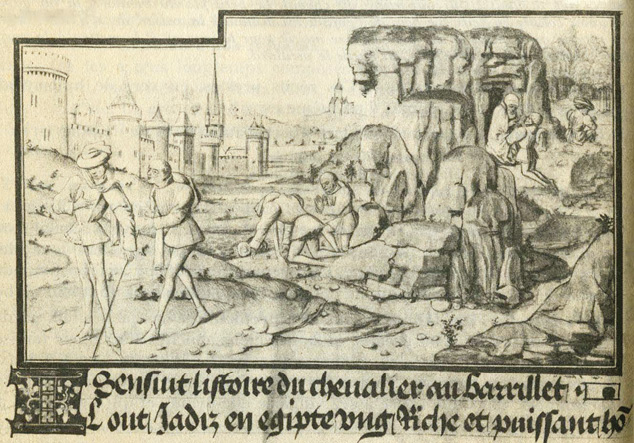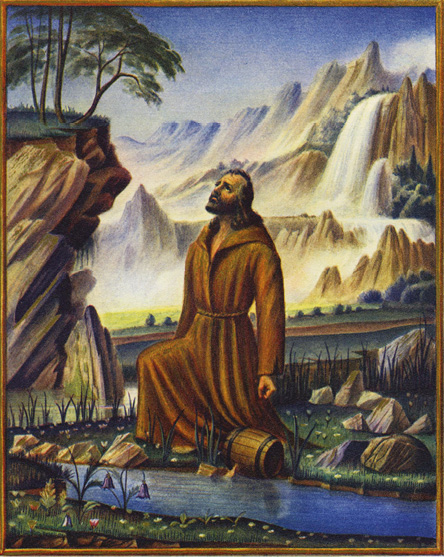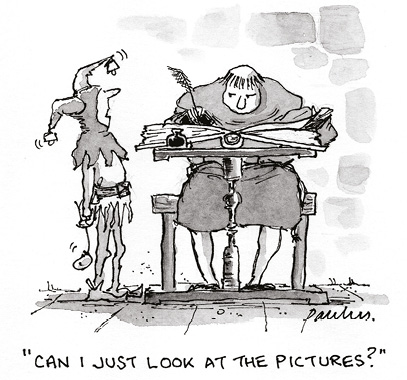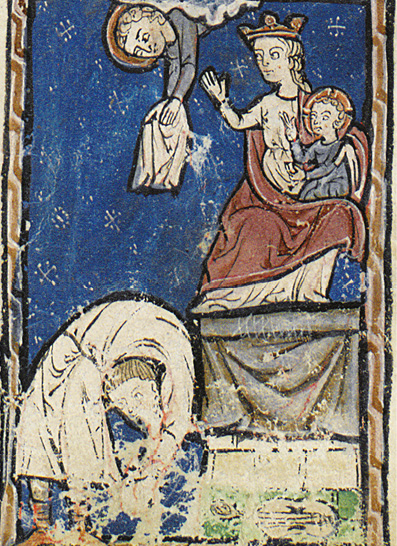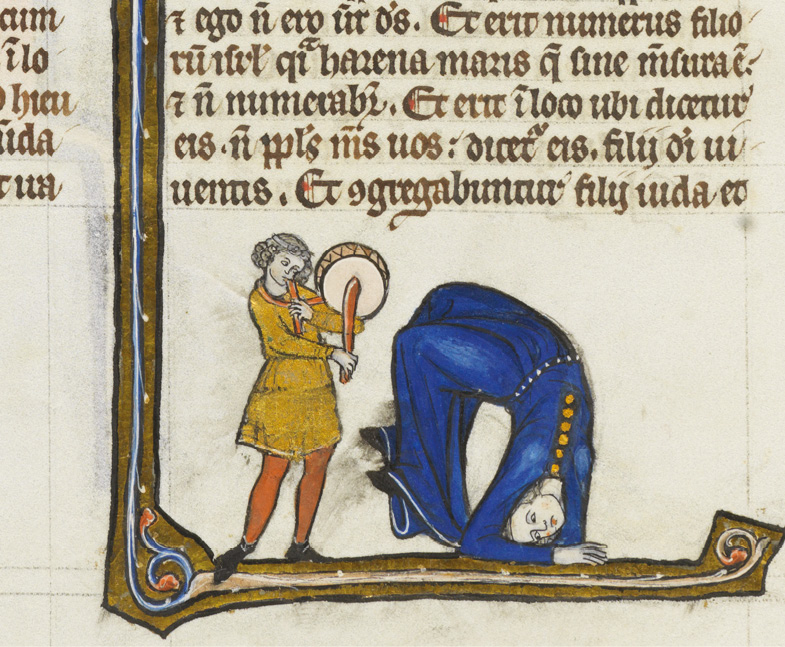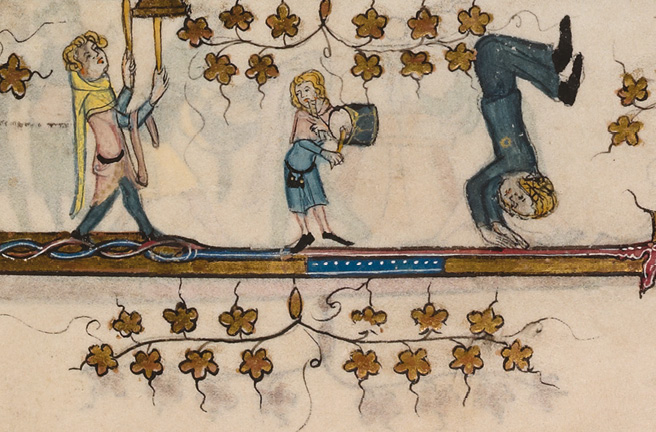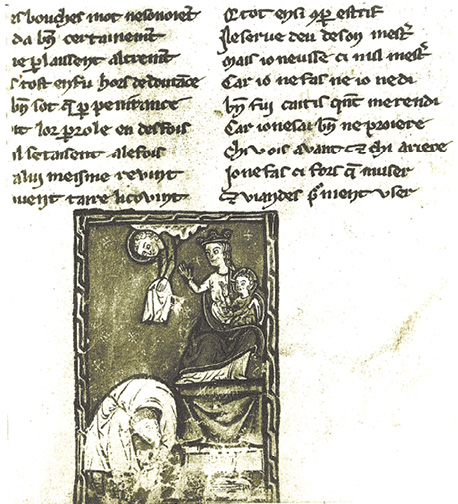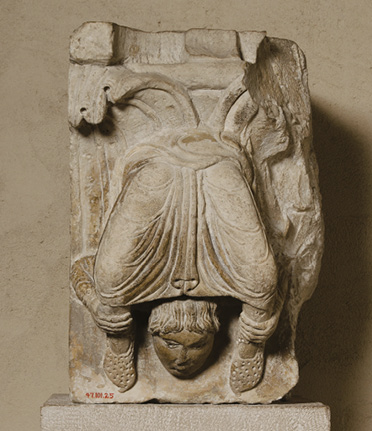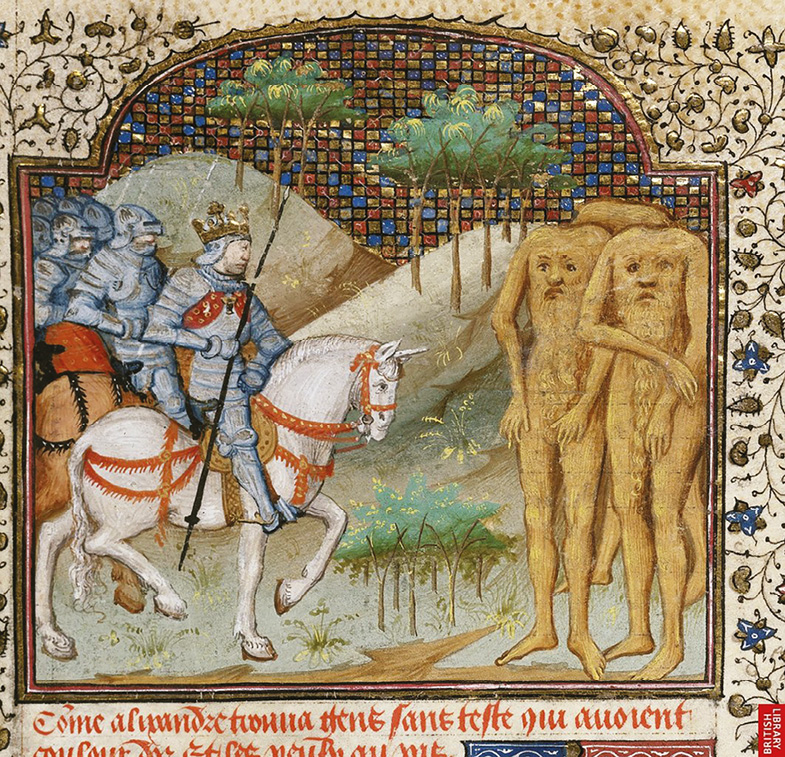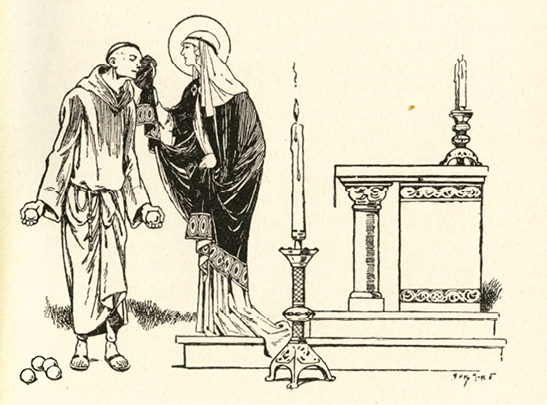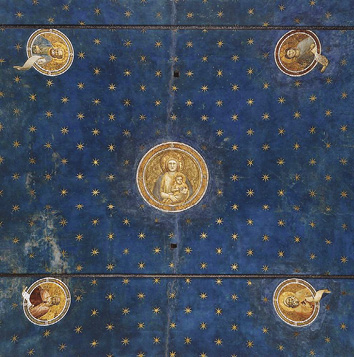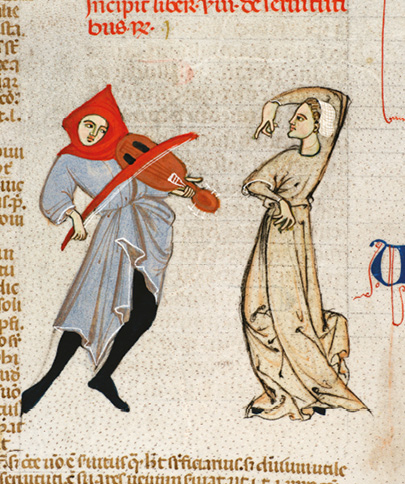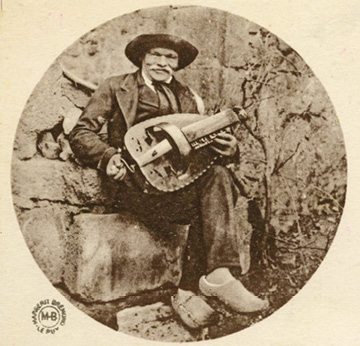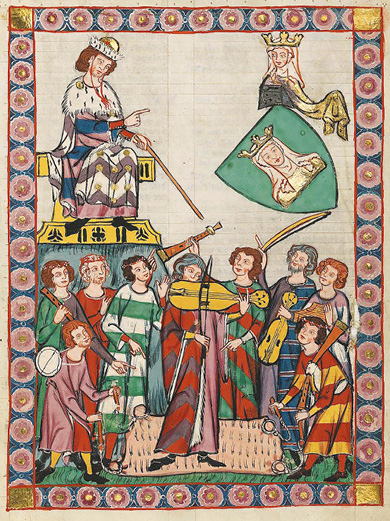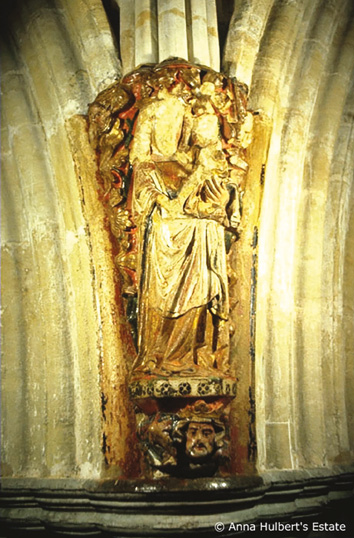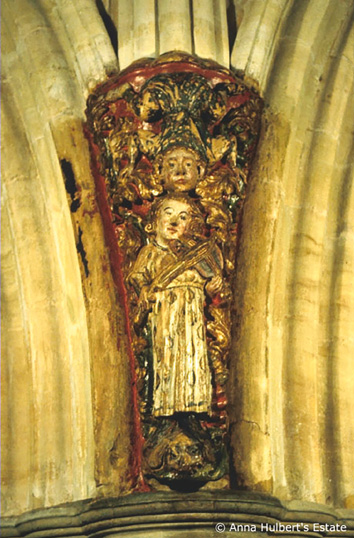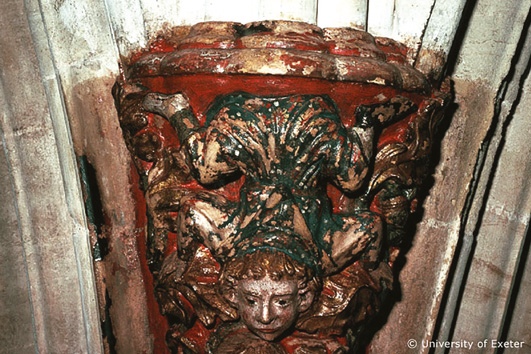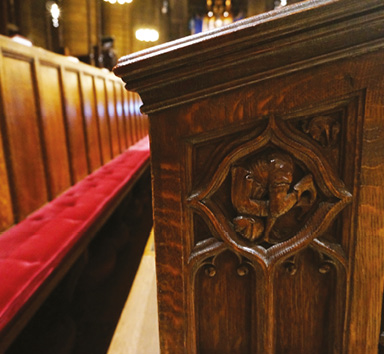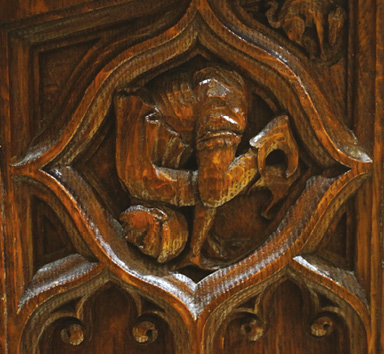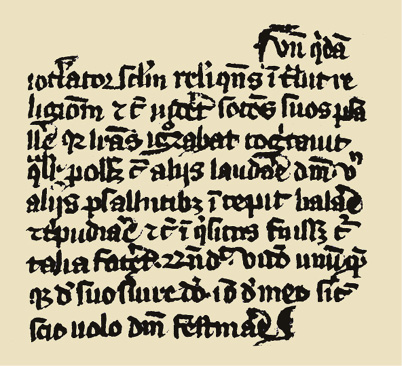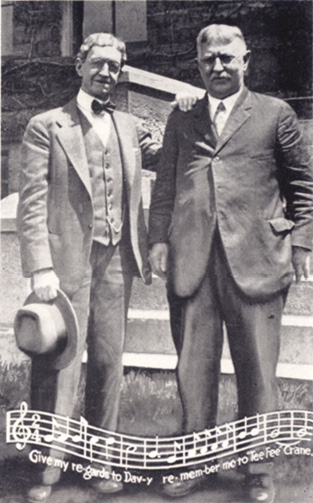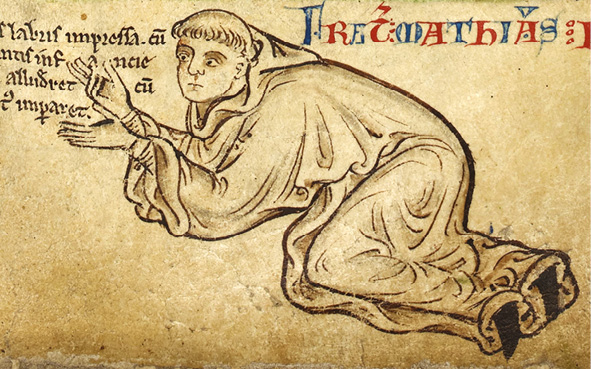1. The Medieval Beginnings of Our Lady’s Tumbler
© 2018 Jan M. Ziolkowski, CC BY 4.0 https://doi.org/10.11647/OBP.0132.01
I find that I always get back to the twelfth century when left to myself.
The French Poem
The poem often called Our Lady’s Tumbler, comprising 684 lines in 342 rhyming couplets, is held by common consensus to be a bright spot of French literature, among the most beautiful texts from the Middle Ages. Magnum opus though it may be, the piece poses quintessentially medieval puzzles. The tale it recounts has also come through to us in a later, no-frills Latin prose version. Rudimentary facts about interconnections between the poem and prose turn out not to be facts at all but moot points. When all is said and done, we can do nothing first except read, reason, and seek out hard evidence. Then we may proceed to formulate, substantiate, and evaluate hypotheses by trying them out in the proving grounds of public delivery. By taking precautions and implementing preventive measures against slipperiness, we can tiptoe around slippery-slope fallacies. Just by itself, the verse in Picard-flavored medieval French remains, in important regards, unexplored territory. Among the unknowns are authorship and precise date of composition. Even more mystifying is the exact relationship between the two actual written texts and any conjectural unwritten forms. Did an oral narrative stand behind the poem that is our earliest datum? Did one, either inspired by the poetic version or independent of it, lead to the later exemplum? At the end of the day, the only two foregone conclusions are the story itself and the manuscripts that transmit it. Both these diamond-hard certainties warrant close examination.
Our Lady’s Tumbler has been termed a “stand-alone moralizing piece.” The tale it tells resembles a specific type of medieval literature known as an exemplum. Exempla, to use the plural, were illustrative stories that furnished entertainment in speeches. By doing so, they particularly enlivened sermons. Generally, they were pithy. While providing a modicum of mirth, the brief narratives, which like most rhetoric were protreptic, served as launch pads for edification. Often they impressed salutary or redemptive ethical lessons. Sometimes they afforded humdrum, concrete explanations; at other times they illustrated complex, abstract doctrinal issues. These exemplary tales can be heterogeneous in nature, but many purport to relate an actual event in the life of a real human being. That is, they are presented as being true. Thus, they can approximate closely what today we might categorize as anecdotes or, alternatively, legends. At the very least, they are usually plausible. Whether they actually happened is almost beside the point.
Preaching became ever more prevalent after 1200. Inside the beehives of Cistercian monasteries, abbots were expected to utter daily homilies in chapter meetings to the monks under their oversight. Beyond this routine expectation, the same community kingpins were also to hold forth in church on festivities, when pontificating was the order of the day. Those feasts, of course, included the major Marian celebrations. The white monks, as those of this order were called, spread throughout Europe, into the Eastern Mediterranean and even beyond. They carried with them their sermons and exempla in speech and writing, and enriched their stock of such narratives with what they heard and read during their travels. The store of these little tales swelled. In the world outside the abbeys, sermonizing proliferated as clerics were reoriented to devote far greater time and energy to the moral welfare and spiritual life of laypeople. In the process, the clergy tasked with pulpiteering developed a taste for enlivening and enlightening their orations with engaging and edifying stories. Eventually the friars, too, became especially enmeshed in proselytizing among the laity. All these preachers, monastic, fraternal, and clerical, felt an imperative to grandstand and to find attention-grabbing tales that lent themselves to moralistic or religious interpretations—in a word, to preachiness.
Both the theory and praxis of homiletics necessitated familiarity, both broad and deep, with exempla. Consequently, the requirements of would-be sermonizers opened up niches for new sorts of reference works. In these books, aspiring orators who sought out stories suited to specific themes could forage for ones that met their needs. They rooted around in exempla collections conveniently arranged in clusters by topic. Alternatively, they consulted systematic “arts of preaching.” Illustrative stories often turned up in the model speeches that were implanted in or grafted onto such manuals. The exempla became only more pervasive as this type of rhetoric took an ever stronger hold on oral and written culture alike. In those two cultures, the noun “sermon” carried a dual meaning. On the one hand, it referred to a declamation proclaimed aloud and live to an audience. The delivery could come from memory, improvisation, a written outline, or a full text. On the other hand, the word could denote a text copied in a manuscript for reading and consultation.
Churchgoing listeners, whether monastic or lay, had far fewer reservoirs of diversion on which to draw than we have today. For them, the exemplum was a happy innovation that came into its own in the thirteenth century. It remained well liked throughout the remainder of the Middle Ages. Viewed from a higher altitude, this literary genre can be lodged within a broader framework. Even outside churches, the late twelfth and early thirteenth centuries saw an explosion of both tales and tale-telling. To describe the trend toward fiction as a development of “story for story’s sake” would go too far. After all, many narratives had lessons or at least germs of wisdom to convey. Yet with or without morals, narrative mushroomed. The formulation “emancipation of story” may be the snappiest catchphrase that has been concocted to describe the proliferation of romances and “songs of heroic deeds,” fabliaux and so-called elegiac comedies, and fables and exempla. Like many others in society, preachers had to be good storytellers if they wished to compete and succeed.
But let us turn inward from context to text. The poem of Our Lady’s Tumbler tells a stirring tale of a professional entertainer who specializes in dizzying double somersaults, light-footed leaps, and other such feats. In our terms this key figure might be called an acrobat, gymnast, or dancer. All three pursuits involve nonverbal bodily movements that are intentionally rhythmical, and all three follow patterned sequences. All three have interdependences between body and emotion, in strong contrast to the associations of linguistic expression with the mind and reason. Dance constitutes a symbolic form of communicating and representing. Its connection with symbolism elevates it. Yet it is also ineluctably physical, with the positives and negatives that corporeality entails. The hero of the poem is radically new, a role model who is simultaneously a roll model.
Whatever name we assign to the profession and activities the tumbler transacts in the story, this simple layman tires of his existence as a secular performer. World-weary, he feels like a misfit, and he cannot stomach any more years of aimless wandering. From the medieval Christian perspective that he assumes, all his possessions are ill-gotten gains. In a sudden and definitive change of heart, and without any forethought, he repents by giving away his hard-earned money, horse, and clothes. He is game now to lead life pro bono. The entertainer aspires to cure his newly developed agoraphobia by yielding to claustrophilia. He joins a monastery as a lay brother, and he plunges in with a blank slate. The abbey is his spiritual promised land. Yet his notions of tabula rasa and a clean break prove to be illusory. All too soon, one form of hopelessness gives way to another. In his new environs, he realizes that he is far from his wheelhouse (or cartwheelhouse). He has no capability for singing or reading. Shortly, he despairs over his inefficacy. He cannot fulfill the duties of a regular monk—in fact, he is incapable even of deciphering the codes of monastic communication and conduct. After one life-changing transition, he needs another. This time he must invent a new life for himself, but within the inflexibilities of monasticism.
Eventually, the jongleur figures out a means for overcoming his life’s ennui. It dawns upon him that his priorities are all amiss. He needs to put the (cart)wheel before the horse: by recognizing in a way uniquely his own that the show must go on, he hybridizes his two ostensibly irreconcilable métiers. The physics of his devotion has its own space and time. To express himself in the only medium he can devise, the tumbler takes to slinking off to the crypt when the robed and hooded monks fulfill the canonical hours above. He leaves it to others to preach to the choir. Instead, in solitude he develops the custom of stripping down from his habit to his underclothes. Upon entering the abbey he divested himself figuratively of his property; now he does a literal divestment. In this array (or disarray), he venerates the Virgin Mary by enacting his devotions in solitude before an image of Our Lady. His reverence takes the shape of acrobatics. His physical exploits are intermingled with breast-beating, sighs, whimpering, and other indicia of penance. The moral of the story would appear to be “As you weep, so shall you reap.” The sequence culminates in genuflection before the Madonna. At the end of the whole-body workout (but perhaps especially the legwork), he collapses, not groveling, but parched and prostrate, lips chapped, lungs gasping for oxygen, his quadriceps heavy as lead.
The story continues. Fellow monks have noticed the absenteeism of the tumbler, who supposedly abandoned the wandering without purpose in which he engaged professionally in the world outside. They remain unconvinced that despite now being at least nominally a monk of some species, he has not lost his bearings and reverted to his old ways. In their petty-mindedness, they suspect him of being shiftless. What does he do while they knuckle down to execute their duties by singing in choir? Could he be lounging, a laggard or loafer? Acting upon their suspicions, they trail him, ferret out his alibi, see his unorthodoxy in action, and disapprove. The lay brother believes that by tumbling, he is worshipping. Their reaction is dismissive: what they observe, they judge as “not a prayer.” Through them, the abbot is alerted to the unaccustomed and nonnormative behavior of the unwitting tumbler and spies upon him, at which moment he witnesses a miraculous visitant. Spoiler alert! The Virgin herself descends from heaven and, in her role as comforter, fans the tumbler. The scheming of the brethren has backfired.
A while after this celestial encounter, the overwrought entertainer is summoned to a meeting in the abbot’s quarters. The lay brother is tied in knots with worry. Has he transgressed by riffing so radically on the regular worship? Has he committed not really but metaphorically a faux pas? Will his superior have him ejected from the abbey? Will he be defrocked for his frocklessness in the crypt? All these anxieties prove to be ungrounded. Instead of being reprimanded and penalized, he receives a commendation. In the view of his spiritual father, his dance routine gives evidence not of shirking but of supererogation: it is a balletic form of going above and beyond, except it takes place below ground. Relief washes over the tumbler. What happens next may seem a kind of physiological non sequitur. Beyond the physical drain of performing multiple times a day, he has been under insufferable psychological duress. The sudden turnabout from anxiety to reassurance and relaxation overloads his constitution, which has become damaged through overwork. He immediately falls ill and soon expires. In one sense, he has attained the release from life that is designated technically as quietus. Peace and salvation have been his goals, and now he has reached them. From another perspective, he has truly worked himself to death. He has achieved the ultimate in work-life imbalance.
Thanks to another intervention by Mary, angels wrest the tumbler’s soul from demons who have swooped in to claim it as their own. Despite being the beneficiary of the Virgin’s leniency, in neither case does he witness the act himself. He cannot measure up to a saint. He has not died after being martyred nor after living an entire life of unpolluted virtue, from cradle to grave. At the same time, beyond the shadow of a doubt, the entertainer who has become a lay brother has won ringing endorsement from the Mother of God. Although he is rail-thin and worn to the nub by asceticism, what happens around him are not his own fatigue-induced hallucinations. The miracles may function to his maximum advantage, but they take place unbeknownst to him. Rather, they are genuine epiphanies to which others can testify. They are wonders for which impartial, even skeptical eyewitnesses can vouch.
If we dissect the tale and seek to taxonomize it within present-day categories of literary genres, we might waver in classifying Our Lady’s Tumbler. The genre of the poem, if not altogether uncharacterizable, is problematic to characterize—but fortunately those who write literature have often been much less fussy about generic exactitude than those who criticize, historicize, and theorize it. We could sort the poem under the heading of short story, if we regard the account as fiction. Alternatively, we could class it as minor biography, if we buy that it was meant to be taken as a record of reality—a moment in history. We could compare it profitably with the Occitan literary form called vida, which presented in prose a brief life story of a troubadour. Then again, we could subsume it within one subset of writings about the saints. Hagiography encompasses writings on the lives and deaths of saints, their miracles, and the fate of their mortal remains. By this measure the French text fits squarely within the form—it recounts a miracle tale about the Mother of God, who is a saint even if the tumbler is not. To go a step further, it tells a double wonder: In the first instance, the Virgin intervenes to succor physically a devotee of hers. In the second, she tops her earlier assistance by interceding to save his eternal soul from hell for heaven. The poem is technically a soteriological Marian miracle tale, in which the Mother of God performs a wonder to redeem an individual. As such, it falls within a subgenre of miracles about Mary that is not attested definitively before the eleventh century.
To return to familiar territory, the narrative unfolded in Our Lady’s Tumbler is an exemplum, just as the preamble to the poem declares. As might happen in a sermon, the tale concentrates our undivided attention upon reversals in stature. The tumbler has attained worldly success and prosperity, which he abandons. Within the monastery, he rates himself a total washout. Yet in the end, he manages to reach the ultimate of un- and otherworldliness. He attains recognition by securing a lifeline twice, both times courtesy of Mary. Our Lady’s Tumbler conjures up a hefty set of oppositions. It sets in competition the categories of lay and monastic, literate and illiterate, official and unofficial, public and private, liturgical and non- or paraliturgical, verbal and nonverbal, devout and blasphemous, and even aboveground and underground. Indeed, the list of such antonyms could be extended almost without end. What is more, the poem raises urgent questions about love, regarded at least nowadays as quite possibly the most powerful and mysterious aspect of human life, whether directed toward another person, God, or both.
But we get ahead of ourselves by delving into such subtleties and shades of grey before dealing with more elementary issues. Prompted by the medieval text, our path must commence, whether we recognize it as such or not, with words preserved in ink on parchment. We must toe our way carefully, letter by letter, across and down painstakingly prepped and smoothed rectangles of cowhide. The manuscripts that transmit the text help us to hear the words and read the minds of people from the Middle Ages. A codex has an altogether different shape from a low-caliber revolver, yet if we seek out a smoking gun in the distant past of the Middle Ages, we need to start our search for the fumes by looking at the books made of animal skin.
The Manuscripts
Manuscripts can bear a deceptive resemblance to printed volumes, but by their very nature the first are handwritten (Latin manu “by hand,” scriptus “written”). Consequently, all such products are unique. No mass-produced items of this sort exist, any more than do assembly-line medieval cathedrals. No two styles of penmanship are the same. These objects, each one of a kind, pump the lifeblood of medieval studies, or at least fill the circulatory system for that vital force. In many respects, they were the vascular network of the Middle Ages themselves. They constitute the veins and arteries of the bloodstream through which medieval folk, especially the educated, have been best able to reach across the centuries and millennia and to communicate with us—and we with them. For all the skewing that results from their being the output of literate elites, such codices have always offered a sweet spot for access to the minds and hearts of many medieval people. By metonymy, they present medievalists an illusion that the era in which they specialize is remote but not intangible. Parchment leads to poetry and prose. Poems take us all the way to poets.
Books made of vellum and its kin embody a massive societal commitment. The investment came partly in what might now be called “staff time.” Preparing an animal skin to create a proper writing surface, penning texts upon it by hand with quill and ink, and binding it into a codex were all labor-intensive processes, often requiring teams of specialists. This cursory conspectus elides many steps in the production of even the plainest of plain-vanilla manuscripts. The economic costs of materials were also real and mounted high. The pelts employed for parchment could have been used instead for fabricating clothing, buckets, harnesses, or any of the thousand other functions that leather fulfilled in the Middle Ages, which plastics or synthetic fabrics might serve today. Although the parchmenting process often renders the hide soft and smooth, the resultant material is tough. It may be scuffed, scratched, and snipped, but it can stand a lot.
Where manuscripts now reside holds interest, but far more consequential than the libraries in which they sit today is where they originated and how they relate to one another. In total, five codices of the thirteenth and fourteenth centuries preserve the verse work Our Lady’s Tumbler. The original, at least as it has been handed down to us, is recorded in a form of French marked with many features of the language spoken and written in Picardy, a territory in the northern part of France. It could be termed Franco-Picard. The relationship between the literary idiom now customarily called Old French and the living colloquials or dialects grouped under the name Picard remains heatedly debated. When the poem was composed, the pecking order of languages within France was not yet established. Picard has devolved into a regional tongue or dialect under the overall umbrella of langue d’oïl, the language employed in the northern half of the country and other nearby areas, but in the early thirteenth century, the linguistic and dialectal spectrum looked very different. Whatever label we attach to what is now a patois, the important thing is that the text is, and had to be, in the vernacular. It tells of a leading character who is nonclerical, illatinate, illiterate, and unlearned. Without making a conscious effort, he contests the world that belongs to his Latin, literate, and learned confrères. Thus, it juxtaposes very deliberately at least two or three discourses and sets of values.
The text’s prototypes have vanished. We do not have a rough draft that the poet wrote out himself or that he dictated to a scribe. We lack even the next stage of a clean and corrected version. But we possess one manuscript closely related to the lost original. The other four all seem to stand at two or more additional removes from the hypothetical author’s original, or holograph. The unconfirmed authorial fair copy is sometimes designated the urtext, a term taken from German. The affiliation of the handwritten versions has been set down graphically in a genealogical chart that is known as a stemma (see Fig. 1.1).
Fig. 1.1 Stemma of Our Lady’s Tumbler. Vector Art by Melissa Tandysh (2014) after Hermann Wächter, “Der Springer unserer lieben Frau,” Romanische Forschungen 11.1 (1901): 299. Image courtesy of Melissa Tandysh. All rights reserved.
This kind of diagram is meant to isolate what is styled an archetype. This primogenitor sires a lineage of descendants, whose relative purity and propriety are to be spotlighted. Low-quality codices are black sheep (or cows, if the writing surface is vellum). We could take the metaphor further to call them bastards in the family tree. The propinquity of copies to the real or hypothetical original is determined by detecting what are called fallacies. Editors of texts, following the procedures of stemmatics, hunt down common errors that are shared by different manuscripts. By doing so, they narrow down how the varying texts preserved in the medieval books are related to one other.
Textual edition and criticism prioritize the identification of supposed misapprehensions by those involved in writing out words by hand. To a degree, these two arts rest on an assumption that manuscripts and the scribes who produce them are error-prone. Consequently, they are often not enterprises that nurture positive and charitable thinking about the work of others. Philologists committed to such pursuits may go to great lengths in tallying errata. Over the centuries, the medieval copyists who have been put under the microscopes of these scholars have been on the receiving end of much obloquy for their real or alleged blunders. Helpless to defend themselves, they have been excoriated over and over again as stupid and slovenly bunglers. They have been taken to task especially for luckless efforts to make changes on the fly when they encountered wording that made no sense to them. Another consideration important for us to recognize is that the processes of editing and criticizing texts were held in the highest regard in the late nineteenth century, when nation-states were created and coalesced in Europe. Researchers contributed to the construction of nationhood by delivering to the public through the educational system the earliest literary expressions of national identities. First, they identified and concurred about texts worthy of being considered foundational. Then they located and validated the manuscripts most faithful to their originals so that they could constitute reliable editions.
In the sort of genealogy that a stemma provides, letters from the Greek and Roman alphabets customarily serve to signify individual manuscripts. Each such designation is called a siglum. In this case the letter O represents the lost original or archetype, which transmitted the urtext. The letter a stands for an early exemplar that was made as a copy of the archetype, although it, too, has not lasted. The alpha and beta, α and β, that come below the Roman letter are two further exemplars that were copied from it. Neither of these is extant either; they also are hypothetical. Tangible and legible reality arrives in the next stage. From each of α and β, two handwritten versions were copied that survive. In each pair, the text of one shows signs of having been affected by consultation of one in the other couple. To indicate this crossover, the sigla of these two are joined by the dashed line that traces an arc between them.
Of the five manuscripts that are not merely hypothetical but indeed exist, one has been deemed higher-ranking by all editors to date for the text it transmits. Its shelfmark, a notation that indicates its place in a collection, refers to the Arsenal library. Although far from infallible, the folios in this codex lack the major errors that are common to all the other codices that descend from the lost archetype, a. This text is largely without the omission or inversion of verses, faults in rhyme, mistakes in diction, and so forth that mar the other exemplars. This five-star copy has been assigned the letter F as its siglum in the stemma. In recognition of its superiority, it has been accorded a fork in the family tree all to itself. Alas, the prime quality of the text does not mean automatically that the manuscript has been passed down to us intact or even in sound condition. Fourteen folios have been vandalized. Most of the miniatures have been cut out, with attendant damage to many texts in the codex. What lingers of the art is the sad equivalent of the chalk on asphalt that outlines where the body of a homicide victim was found. But by exceedingly good fortune the image accompanying our tale remains mainly undamaged. The year in which the manuscript was written and assembled can be inferred from a piece of internal evidence. A perpetual calendar at the beginning commences with the year 1268. For readily recognizable reasons, we can conclude that the poem was composed before then—but by how long? To take on a still more intriguing question, by whom?
Gautier de Coinci and Anonymity
Our Lady’s Tumbler leads off a section in the Arsenal manuscript that mainly comprises miracles of the Virgin. Not one of the codices gives the faintest indication of authorship: in all five the poem is anonymous. The poet’s name may have been present in the archetype but gone missing between it and the earliest codex, or the author may have kept his identity a deliberate cipher. Anonymity would have been consonant with medieval Christian values as a fitting assertion of modesty. Such self-suppression would have been especially appropriate if the writer had been a monk. Remember that the central figure of the poem is likewise unnamed. Since the tale is all about modesty and simplicity, it is apt for both the poet and his protagonist to be nameless. For application to the Middle Ages, the Shakespearean question “What’s in a name?” could be reformulated with equal relevance as “What’s in namelessness?” The anonymity of the title character befits his humble occupation as well as his personal humility. For that matter, the anonymity of the poem itself could be construed as an apt touch of modesty.
Despite the lack of an ascription, many translators and authors who have adapted the story have credited it unequivocally but wrongly to a specific northern French poet and musician in the Benedictine order (see Figs. 1.2 and 1.3). Particularly in France, this Gautier de Coinci has enjoyed favor and name recognition among literati far beyond the degree to which he has been translated and read. He was born in the village of Coinci-L’Abbaye, south of Soissons, probably in 1177 or 1178. Notre-Dame de Soissons was the abbey there, with a church dedicated to Mary. A good-sized portion of the monastery as it existed in the times of this monk withstood the hazards of time until the French Revolution (see Fig. 1.4). At that point the complex of buildings suffered a blindingly rapid demise, from which little now remains (see Fig. 1.5). In Marian relics, the church possessed a slipper of the Virgin that became revered for the miracles associated with it.
Fig. 1.2 Gautier de Coinci at work. Miniature by Fauvel Master, 1327. The Hague, Koninklijke Bibliotheek 71 A 24, fol. 49v. Image from Wikimedia Commons, https://commons.wikimedia.org/wiki/File:Gautier_de_Coinsi.jpg
Fig. 1.3 Gautier de Coinci (detail). Miniature, 1260–1270. Brussels, Bibliothèque royale Albert I, MS 10747, fol. 3r. Image courtesy of Bibliothèque royale Albert I, Brussels. All rights reserved.
Fig. 1.4 Postcard depicting Notre-Dame de Soissons in the eighteenth century (Soissons, France: Nougarède, 1903).
Fig. 1.5 Ruins of Notre-Dame de Soissons. Photograph, 1938. Photographer unknown.
Fig. 1.6 Postcard depicting the Abbey of Saint-Jean-des-Vignes (Paris: Levy Fils et Cie, early twentieth century).
Fig. 1.7 Postcard depicting the cloisters at the Abbey of Saint-Jean-des-Vignes (Paris: Neurdein et Cie, early twentieth century)
Fig. 1.8 L’Abbaye de Saint-Médard, Soissons. Engraving, date and artist unknown.
Gautier grew up in a region tied particularly closely to the Mother of God. Sometime after 1143, a Latin author by the name of Hugh Farsit composed a prose collection of miracle stories, many of them connected with the local Madonna. He was a regular canon of Saint-Jean-des-Vignes, a monastery of Augustinian canons in Soissons (see Figs. 1.6 and 1.7), and his book of traditions about Mary from the vicinity records the miraculous healings she performed in this municipality during the fast-spreading epidemic of ergotism that swept over northern France in 1128. This outbreak is often identified by referring to the French victims as ardents “burning people.” The qualifier alluded to the discomfort that they experienced: the hot and bothered.
At the age of fifteen or sixteen, Gautier himself entered as a novice monk into the Benedictine house of Saint Médard at Soissons in 1193 (see Fig. 1.8). He remained there for more than two decades. In 1214, he became prior of Sainte Léocade at Vic-sur-Aisne, a village within hailing distance of Soissons, and served there nearly twenty years. In 1233, he was appointed Grand Prior back at Saint-Médard, an office that an uncle of his had held. If he had been the author of Our Lady’s Tumbler, he would have had good cause to be impressed by the chilly crypt of Saint-Médard and to think of it as the venue for the tumbling of the lead character in the poem (see Fig. 1.9). The space would have been as striking then as it is today. The poet died in 1236, in the same monastery where he had begun his monastic calling.
Fig. 1.9 The crypt of the abbey of Saint-Médard, Soissons. Engraving by Léon Gaucherel, date unknown.
Between 1212 and 1236, Gautier composed two books of verse Marian miracles known as Miracles of Our Lady. This chronology means that he had two staging grounds for his poetic creation. Although he wrote the individual segments mostly in Vic-sur-Aisne, he began and finished them at Saint-Médard in Soissons. His text achieves an extraordinary range in its language and rhetoric, holds to a careful and goal-oriented plan, and puts on display a discriminating and satirical perspective on both the secular and ecclesiastical society of his day. Many of his versified tales touch at least in passing upon images of the Mother of God. In numerous instances he introduces Madonnas when they were not mentioned in the Latin sources upon which he draws. Eleven of his stories go so far as to involve such representations as characters within their narratives. If Marian miracle tales qualify as a specific literary genre, ones about statues or paintings of the Virgin form a distinct and multipart subgenre within it. Time and again, such narratives were associated with sites where relics of Mary were held, and where pilgrims devoted to her would come.
Gautier’s Miracles of Our Lady were enormously popular, to judge by the total of 114 extant manuscripts. This figure plants his composition squarely in the realm of bestsellers of the day, although none of the codices dates to his lifetime. A dozen of these copies contain extensive musical notation. Twenty-nine have the added drawing power of being beautifully illustrated. Likenesses of Madonnas and of Madonnine miracles constitute a salient feature of the codices. The depictions emphasize figures as they kneel in supplication before images of the Virgin. In the Byzantine world, the act of genuflection was intrinsic within the veneration of icons. In the West, it became anachronistic by the thirteenth century. In writing, Gautier verged on describing himself as a jongleur, or at least as a trouvère or minstrel of his lady, Notre Dame. The stance the poet takes in his text correlates nicely to the pose in which he is presented in one manuscript portrait, where he is portrayed as a musician in black Benedictine monastic garb. While bowing the fiddle-like stringed instrument called the vielle, he looks down at a big sheet of parchment with two facing folio sides of musical notation that lies on the bench beside him (see Fig. 1.10). Thus, like the hero of Our Lady’s Tumbler, he managed to combine in himself strains of minstrelsy and monasticism.
Fig. 1.10 Gautier de Coinci. Miniature, 1260–1270. Brussels, Bibliothèque royale Albert 1, MS 10747, fol. 3r. Image courtesy of Bibliothèque royale Albert I, Brussels. All rights reserved.
When all is said and done, the fact that Gautier was a highly successful poet from Picardy who wrote extensively in verse on miracles of the Virgin does not suffice to ascribe to him the authorship of Our Lady’s Tumbler. For better or worse, we have become acclimated today to requests that we identify ourselves by our names and birthdates, commit to memory and reel off numbers that have been affixed to us by states and businesses, and even surrender to biometric analysis of our fingers, faces, eyes, or more. Naturally we expect the past to bestow upon us at least some of the same trivia about its authors.
But here we must reconcile ourselves to the anonymity in which much medieval literature has been engulfed. Some authors cloaked themselves in this kind of impersonality by choice, for reasons of Christian humility or owing to differing conceptions of authorship. The indifference of scribes or the happenstances of sloppy transmission imposed namelessness upon others. In any case, the identity and individuality of authors mattered far less, or at least far differently, in the Middle Ages than now. Many works traveled under aliases. Along with Pseudo-, Anonymous was the most prolific of medieval authors. She or he composed Beowulf, The Song of Roland, and Aucassin et Nicolette, to name only three texts from the many that spilled out from the cornucopia of anonymity.
In the same company, the poet of Our Lady’s Tumbler has no name right now. Indeed, none is likely ever to be accorded that will win general agreement. In medieval times, stories tended to be treated as in the common domain, whether they surrounded legendary figures of late antiquity or the early Middle Ages such as Arthur and Charlemagne, were connected with the heroic wars and haphazard wanderings of classical myths relating to Troy and Thebes, or celebrated the travails and triumphs of saints. No conventions of copyright existed, let alone of royalties, and the conception of plagiarism differed starkly from our own. Both copyright and unacknowledged borrowing have been under constant renegotiation since the advent of personal computers. The authors, collectors, scribes, readers, and hearers of medieval literature appear often to have been untroubled about the fine points of authorial rights.
Many authorless texts from the Middle Ages are subject to a high degree of textual variance. With each rewriting by a scribe, they have been affected by variations in dialect, minor changes in lexicon here and there, thoroughgoing expansion and contraction, and sometimes even more drastic redrafting. This sort of textual mobility, a hallmark of manuscript culture, is alien to the fixity that has become expected of printed texts. It has been described with an imported French word, mouvance.
No deduction about the author of Our Lady’s Tumbler is unquestionable or unimpugnable, beyond the fact that a poet was at work—and a very fine one at that. Yet when all is said and done, the anonymity need not deal us as expositors a crippling blow. All is not lost. We can still gain some sense of him, and an even greater one of the characters in his Our Lady’s Tumbler. The challenge is to exercise caution and not, in our eagerness to know the writer, to draw any hasty inferences. The unnamed poet had his finger on the pulse of monasticism, but he need not have been a monk. He knew the minstrelsy, but he does not have to have been a minstrel himself. Regardless of his status, we have a fighting chance of determining the pecking order of human values in which he participated. In that valuation, the spiritual was privileged over the material. The ne plus ultra was to attain heaven through a mystical communion with the divine. But let us get both feet back on the ground, by examining the language and region with which the poet and poem are associated.
Picardy
Of the five medieval manuscripts, the earliest witness for Our Lady’s Tumbler survives from the second half of the thirteenth century. As mentioned, the poem has been described as being in Old French, the tongue spoken in the northern half of modern France and related regions from the ninth through the fourteenth centuries. Yet attaching this linguistic tag to the tale may oversimplify and distort the situation. The study of French in the Middle Ages, like that of most medieval languages, was established in the nationalistic atmosphere of the late nineteenth century. To serve the end of buttressing nation-states, the major languages of Europe that existed or were being willed into existence at that time were read back into the medieval past. The dialect that became modern French was in fact hardly the most important in the literary production of twelfth- and even thirteenth-century France, but its later centrality was retrojected upon it by the philologists who constructed the field of Romance philology.
The patriarchs of Old French in the glory days of the field lived in a world of nationalism. Furthermore, their nation under the Third Republic revolved around a clearly defined and outsized capital city. If Paris was the axle, it was set into a hub, the greater Parisian region known as Île-de-France. This conceptualization does not apply to the Middle Ages, but it was forced upon it by simultaneous anachronism and anatopism. By the late nineteenth century, dialects existed on the margins of a standardized official language, French. The concept of Old French assumes the existence of a similarly standard idiom already during the medieval period.
By the touchstone of today’s population distribution, at the very northern tip of what is now France, Picardy may look peripheral. The territory is extrametropolitan, since it lies outside Paris. France has many cities but at the same time the country has been centralized for centuries now around the capital. The national transportation systems and governmental reporting structure may be visualized as a set of spokes radiating from what is now the City of Light and reaching out to the felly of the French frontiers. Yet this was not the organization of communication and power in the early thirteenth century, when Our Lady’s Tumbler was written. Localizing the poem in this northern area and in the Picard dialect likely means that the poet in fact was born, reared, and lived in that region. Those credentials place him at a long distance geographically from daily life where the events of Our Lady’s Tumbler reputedly occurred. Clairvaux was a monastery in Champagne. Among other things, it was the abbey of Saint Bernard, from its foundation as daughter house of Cîteaux Abbey, mother house of the Cistercian religious order of monks and nuns, until Bernard’s death in 1153. The white monks sought to reignite strict observance of the Rule of Saint Benedict, framed in the day of the founder himself, and to hammer home self-sufficiency through manual labor, as early Benedictinism had done.
Obviously, the poem cannot have been written after the earliest datable manuscript in 1268, but the earliest surviving record of a text can come from long after the time of its writing. In this case, a frequent conjecture suggests that the text was composed around 1200, or even in the late twelfth century. The most thoroughgoing analysis has pegged the dating approximately in the late third decade of the thirteenth century. The linchpin of this chronology rested upon resemblances to the poetry of Gautier de Coinci, who died in 1236. As to place of origin, the most cogent hypothesis has been that the poet settled as a white monk in Ponthieu, a feudal county in northern France. Yet this reasoning, close to being a sophism, capitulates to the fallacious argumentation that is called the thin edge of the wedge. The premise that the writer was a Cistercian arises from the glowing praise that he gives to retreat from the world. The supposition that he belonged to a community in this particular locality has only one toehold: he singles it out for mention once. Both inferences are tenuous at best.
The Identity of the Poet
In a way, the name of the poet is nearly extraneous. Even if we knew this one detail in isolation but had no certitudes about social class, educational background, or other life circumstances, we would be no better positioned for guesswork about how his biography could inform our interpretation of the work. The style and content of the poem are tantalizing, since they imply that its writer was as sure-footed a metrist as his protagonist was an athlete. Although incontestably literate, he does not have all his facts straight about Clairvaux, however. Still, he was reasonably well acquainted with monks and monasteries. His ready knowledge of monastic life has long led some readers to assume that he was likely a brother himself, but the groundwork for this assumption warrants close and careful appraisal. The delineation that we are given of the tumbler’s life among the lay brethren may be a touch misleading. No one in his capacity would have been allowed to rove daylong—or at least during all the eight canonical hours of prayer—without having set duties. Coenobites were closer to being battery hens than free-range chickens.
At the same time, the author of Our Lady’s Tumbler also had deep involvement in the lay world outside the monastery. He comprehended the simultaneous awe and alienation that the laity felt before the wealth, sophistication, and foreignness of abbeys and life inside them. Nothing would have stopped a knowledgeable layman outside from writing of a lay brother’s experiences within a cloister. The poet tells a tale that gives no hint of being intended to establish or popularize a shrine, monastic or otherwise, as a pilgrimage site. Yet the poem could have been meant to disseminate the fame of the Cistercian order generally. More particularly, it could have served to highlight the contributions that lay brethren made inside the order, as well as to uphold the esteem in which they deserved to be held within it. Could the poet have been privy to the inner workings of both classes of brothers, from having taken the cloth only after having lived a relatively long life as a laic? The reality is that uncountable, not fictional medieval monks and friars found their monastic vocation and donned a habit only after having spent full lives in the world.
An argument framed just about a century ago posited that the poet of Our Lady’s Tumbler was identical with the one who produced two other anonymous medieval French poems from the beginning of the thirteenth century, The Knight of the Barrel and The Hermit and the Jongleur, going so far as to posit Our Lady’s Tumbler to be a pendant to the latter. The case was built on strong similarities in language, versification (including rhymes), themes, and motifs. Both tales relate narratives that could be reckoned as exemplary in a twofold sense. First, they tell of characters who provide sterling examples to imitate and emulate. Second, they could easily be imagined as having been or as becoming exempla, those short tales used in sermons for illustrative purposes. Both stories have as their point of balance the theme of repentance. Although the penance takes place near religious figures, it does not require in either case a priest or mea culpa.
The Knight of the Barrel is anything but a barrel of laughs; it is more like the medieval equivalent of a bucket list. Its outcome demonstrates the principle “Only tears will be weighed at the Last Judgment.” In this tale, a venerable hermit charges a cruel, impious, and blasphemous nobleman with filling from a rivulet a keg that he gives him (see Fig. 1.11 below). After the water refuses to enter the under-hydrated container, the knight sets out a-wandering. At each spring or river he passes, he tries to fill the small vat. Only at the end of his existence does the nobleman return to the old solitary and shed a tear for his former life of misdeeds. This one sign of contrition is the defining moment in what is revealed to be the archetypal sob story. As it turns out, this single globule of liquid suffices miraculously to leave the little vessel waterlogged. The sole deposit from his lacrimation is the drop in the bucket that gives the lie to the proverbial turn of phrase. Just as Our Lady’s Tumbler compels its audience to ponder the nature of true devotion, so, too, The Knight of the Barrel impels its readers or listeners to contemplate the purport of penance (see Fig. 1.12 below). In modern figurative use, we describe a forgetful so-and-so as having a mind like a sieve, since by design this utensil normally fails to retain all its contents. In the medieval tale, one special barrel performs differently from usual ones, so that it may serve as a spiritual test.
Fig. 1.11 The Knight of the Barrel. Miniature, from an unidentified manuscript in the Bibliothèque nationale de France, Paris. Reproduced in Émile Abry et al., Histoire illustrée de la littérature française (Paris: Henri Didier, 1946), 32.
Fig. 1.12 The Knight of the Barrel. Illustration by Pio Santini, 1946. Published in Jérôme and Jean Tharaud, Les contes de la Vierge (Paris: Société d’éditions littéraires françaises, 1946), between pp. 140 and 141.
The second poem, The Hermit and the Jongleur, is extant in two additional versions. One of these adaptations is by a poet who has been held to be a Cistercian. The story had a rich afterlife in exempla as well. Thus, its transmission presents loose parallels to that of Our Lady’s Tumbler.
In the opening three lines, the poet flags as his inspiration the genre known as Lives of the Fathers (citing its common Latin title overtly)—and the relationship is unambiguously one of source and influence. The title that this poem cites in the learned language corresponds nearly verbatim to that of the French Life of the Fathers, from which Our Lady’s Tumbler likewise claims to have drawn its story.
The tale sketches a hermit who displays such devotion that God sends him his sustenance by way of an angel. Regrettably, being distinguished by this signal honor makes the loner grow self-important and insolent. Emboldened, he asks to be told who will accompany him in paradise. To his displeasure, the spirit relays God’s fiat: his companion will be a jongleur. In this instance, the performer turns out to be a fiddler. The ascetic puffs up indignantly that he has expended no inconsiderable efforts in his religious life; he does not appreciate being made to share his lot in the afterlife with a base entertainer. The messenger of God replies that by divine grace a repentant sinner can become rich in good works. The recluse then strikes out to find his promised companion. After leaving his abode and going to town, he encounters in the market place a poor but pious jongleur who has no means of earning his keep except with his stringed instrument and bow. After being upbraided by the skeptical solitary, the musician furnishes three examples of his virtuous conduct in the past. When the minstrel learns afterward from the hermit what has been foretold, he passes out. Upon regaining consciousness, he announces his intention to remain with the recluse. When the two return to the hermitage, its previous occupant finds himself locked out for his affront against God. An angel wafts down and signifies that the offense has been venial, but predicts that after three days the reclusive fellow will be pardoned. Yet one holdup arises: his companion will enter paradise before him. After two days and a night of prayer in penance, the fiddle-player becomes debilitated and dies. On the third day, the man of God also expires. Attendant spirits ferry their souls to paradise.
The poem of The Hermit and the Jongleur is pious, but for whom was it intended? Likewise, who wrote it? It belongs to a clump of tales that has been labeled “the cycle of brotherhood.” The tag describes characters who are related, much as siblings would be. They share an aspiration to achieve perfection and to determine their salvation through their demeanor on earth. Yet they issue from disparate social strata and vocations. In all three cases, those of The Hermit and the Jongleur, The Knight of the Barrel, and Our Lady’s Tumbler, we the readers are left guessing whether the poet was a monk or not. Without a doubt, he was conversant with monastic life. For all that, he was under no contractual obligation to make his composition a versified customary: he does not have to detail hour by hour the practices of brothers. By the same token, in the imaginary landscape of his poem he was not constrained to abide exactly by the architecture of Cistercian churches. The author could have been a onetime professional entertainer but now a monk, formerly drilled to satisfy lay audiences but latterly dedicated to his monastic brethren. He would have known how to address both insiders, the cliquish cenobites within monasteries, and outsiders, such as prospective converts who came from professions as marginal as his had been. And he would have been intimate with the type of protagonist he portrayed in Our Lady’s Tumbler. The poem, like its hero, has a topsy-turvy quality that enables it to beckon to both the status quo and its revolutionary opposite.
The Bas-de-Page Miniature: Of Marginal Interest
Fig. 1.13 “Can I just look at the pictures?” © Paul Taylor. All rights reserved.
Medieval literature plays out first and foremost, textually, artistically, musically, and otherwise, in the manuscripts that transmit the texts. The codices are often the sole equivalents we possess from the Middle Ages to printed books, audio-recordings, live performances, musical notation, illustrations, or most of the other media we take so much for granted nowadays. When those handwritten objects contain artwork, it should be vetted with the greatest care. In addition to its own inherent value and importance, it holds importance for its relationship to the text. Literary critics may use the written word to achieve interpretative liftoff, regarding the art as no more than an auxiliary element in the interpretative context. Art historians may do the opposite. To a degree, both are right. The two sets of experts contribute essential perspectives to an understanding and appreciation of what the codices furnish us. In some cases, medieval art and written work may be meticulously aligned. Often, but not always, the interpretation of the words dictates the pictures that are supplied. In other instances, the art leads a life of its own—text and image are on the same page literally but not metaphorically. That is the situation with the miniature accompanying our poem from the early thirteenth century.
In the case of Our Lady’s Tumbler, the original text has motivated many modern literary imitations. Do we dare go so far as to call them knockoffs or even rip-offs? Be that as it may, some of these copies have been inspired directly by the medieval poem, while many more have been tied to it only unconsciously and indirectly. Alongside the literature, pictorial representations of the tale have also existed since the Middle Ages. Still, the precariousness of the early evidence for illustration must be underlined.
Fig. 1.14 The jongleur before the Virgin and Child. An angelic hand delivers a towel from the heavens while a vielle lies at the Virgin’s feet. Miniature, thirteenth century. Paris, Bibliothèque nationale de France, MS Arsenal 3516, fol. 127r. Image courtesy of Bibliothèque national de France, Paris. All rights reserved.
As we have seen, a fivesome of medieval manuscripts transmits the text of the medieval French version. Of the five, just one contains a miniature by way of embellishment (see Fig. 1.14). The persistence of this single illustration hung on a thread in multiple ways. For a start, more than two dozen other paintings that should precede this specimen have gone missing by being sliced out of the manuscript at some point in its mysteriously checkered past, becoming nondigital clip art. It is the lucky survivor. If only it could talk, to tell its story as in the Book of Job: “I only am escaped alone to tell thee.” Another fragility of the artwork owes to its placement on the folio. It differs from most in its codex, and in fact from those in any whatsoever, by being unusually misaligned. It sits in what would otherwise have been the unwritten-on and unornamented void below the left column of text on the folio side, which in French is termed bas-de-page, designating the lower edge of a side of parchment. In illuminated manuscripts, embellishments and marginal illustrations often appear in this area, but only atypically would a miniature in a contained frame be put there in the border. This placement was avoided for a good practical reason: by being set at the foot of a page, a piece of this kind is subjected to increased wear and tear from handling and from trimming. (It has no margin of safety.) By being enclosed, such a painting stands out from unenclosed marginalia, which are far more commonly found in this location. The nonstandard placement was probably not prearranged. Rather, the item may have been an afterthought supplied only after the text had been written. The inference that this artwork was a late addition is fortified by the stylistic separateness of the portrayal. The brushwork was done by a different hand than that involved in all the other extant pictures from this codex.
The artist has been associated with the one who participated in producing a copy of Chrétien de Troyes’s Perceval and its Continuations that may have been created in Arras. In this town in the northernmost region of France, an extremely famous miracle connected with two entertainers and involving a statue of the Virgin Mary was reputed to have taken place. Although the episode is not mentioned in our poem, it may help to explain why the miniature contains a depiction of the vielle. An artist, patron, or both would naturally have associated and conflated the tumbler-minstrel with the renowned pair of local jongleurs, promoted by a municipal confraternity. If the composition is viewed as a stage setting, the instrument is placed lower stage left. It lies at the bottom of a line that runs to the semiotically all-important position of upper stage right, where a supernal forearm extends a fabric toward the bowed acrobat. Is the fiddle meant to recall the professionals of the other stories?
Within the text of the poem, the seminudity of the tumbler is provocative. In contrast, the illustrator painted the performer as anything but half-naked—the athlete is portrayed fully clothed. Indeed, the lithe figure even has his long garment cinched demurely at the waist and is shod in mid-calf boots. Were these touches the results of a purposeful prudery, to avoid showing even a lay brother in substantial undress, or do they demonstrate the irresistible attraction of the other story set at Arras, in which a minstrel would have been clad in his normal attire when sounding his fiddle?
The process by which this illuminator worked is unascertainable. We cannot divine whether the medieval artist read or was read the text, had no direct exposure to it but at least was clued in about the gist of the narrative by being given a short and sweet summary, or was directed by a scribe or manuscript compiler to depict this scene without being told the tale in full. The placement of the miniature—very nearly at the foot of the page as it has now been trimmed—may have been motivated by the simple reality that the space was free, or it might equally have been prompted by the suitability of the position on the folio side to the standing that the performer would have had in society at the time, reflecting the ignoble societal associations that acrobats and dancers endured at the time when the illustration was painted. Within the artwork, the tumbler himself has his head positioned level with his own backside. He stands curved back upon himself, below the plinth on which the statue of the Virgin and Child begins. Thus, the representation conveys abasement both literal and figurative.
In Romanesque statuary, we find jongleurs pictured in privileged places on façades, portals, and capitals throughout Europe, or at least from Germany and the south. In the Gothic period, only slightly later, the entertainers seem to have cascaded to lower orders, and slipped as well to a back seat within the iconographic hierarchy. Their images are now placed in subservient locations. For instance, they are depicted on the underside of the folding seats known as misericords, wooden carvings found in choir stalls, to say nothing of their place in miniatures and marginalia in manuscripts. Just as a lay convert has baser status than does a choir monk, so too the location of the image on the folio could be construed as signifying its humbler value.
The English adjective humble derives from the Latin humus, for soil or ground. By setting the miniature at the farthest point from the top of the page, the artist or the person overseeing him may have intended to humiliate—put down—the humble tumbler. Strikingly, the angel, Virgin, and Child are positioned far above him. The tumbler is located before the statue of Mary and the infant Jesus on the altar, with his head at the height of his buttocks. This could be called making a rumpus, even though the last noun owes no etymological debt to the word rump. His head is cocked downward and groundward, and his line of sight is directed at his own hindquarters, rather than at the carving above him. Talk about low-profile! If the lower classes are supposed to aim at an ascent to the upper, what are we to make of a man who is the opposite of a social climber, with his head not far from the floor? Matters are made only worse by the fact that the ground is in a crypt, itself the lowest space within the building.
Humbleness is one of the tumbler’s conspicuous traits. A nineteenth-century interpreter averred point-blank that the tale had been composed “to debase pride and exalt humility.” It is much likelier that the protagonist’s physical posture makes his meekness plain to see than that it conveys a message that we should damn the acrobat or dancer for ungodliness. The condemnatory alternative meaning can be found in an exemplum that compares a sinner with a jongleur who ambulates on his palms with his feet turned heavenward. Whereas human beings should do their best to keep their heavy-lidded eyes open on the supernal realms, entertainers subvert normal human bearing and do the opposite. In their upside-down stance, performers effectively trample what is heavenly, while fixing their heads and gaze, along with their hands, on the earthly.
Another perspective is to view this liminal location as sitting outside the official realm of control over the elite and sacred. Instead, this position at the threshold sets the illustration within a space reserved for the least hoity-toity, popular or folk culture. In a sense, the miniature resides in a no-man’s zone. The bas-de-page is seldom occupied by miniatures, but often by marginal art. It can become a veritable freak show, depicting drolleries and grotesques such as fools, wild men, monkeys, monsters, and minstrels. One common form of marginalia that may offer a glimpse of real-life performances portrays two entertainers who show the bread and butter of their trade: a musician strums an instrument alongside a male or female acrobat who performs a somersault, flip, or handstand. These representations are always parked in the lowest register of the folio sides (see Figs. 1.15, 1.16 and 1.17). In codicological terms, art in this ribbon of parchment is comparable to carvings in wood or stone, such as misericords, chimeras, and gargoyles, that lay somewhat outside the controlled formulation of iconography. Consequently, the imagery is itself marginalized and is put beneath the text, in value as in position. The placement could bring home visually and symbolically the story’s revolutionary outlook on lay and monastic relations—to wit, the jongleur holds a questionable ranking even within the laity but with the help of Mary’s reaction to his sincere devotion, he turns out to be superior spiritually to the monks. Then again, such an interpretation could conceivably be overthinking. The miniature could have been put in the bas-de-page not through premeditation but through poor planning or mismanagement, which unwittingly saved it from damage when the other miniatures preceding it were excised.
The image may be easier to appreciate closely in a black-and-white facsimile made in the early twentieth century, because in the meantime some degradation has taken place: part of the bas-de-page has been trimmed off (see Fig. 1.18). Occupying the bottom left quarter of the frame, the miniature shows the tumbler performing acrobatics by arching backward in a hoop. The depiction could offer the freeze-frame view of a gymnast in the middle of a backflip. A performer is captured in a similar circular pose, with his hands clasping his lower legs above the ankles, in a portion of a sculpted limestone pilaster that is now in The Cloisters (see Fig. 1.19). Then again, and perhaps likelier, the miniature need not be a split-second of seeming stillness that has been isolated from lightning-fast motion. It could portray a specific pose the acrobat has struck. It could show him not midway into a backward flip, but rather in the gymnastic position known today as a bridge. He is recurved, like the tusk of a wild boar or an elephant. Frozen in this posture like an (athletic) insect trapped in amber, he has bent backwards until both his soles and his palms rest upon the ground. Literally as well as metaphorically, he is no backslider. Instead, he is well grounded, levelheaded, and down-to-earth.
Fig. 1.15 Musician and tumbler. Miniature by Petrus de Raimbaucourt, 1323. The Hague, Koninklijke Bibliotheek, 78 D 40, fol. 108r. Image courtesy of Koninklijke Bibliotheek, The Hague. All rights reserved.
Fig. 1.16 Musician and tumbler. Miniature, late thirteenth century. Lausanne, Bibliothèque cantonale et universitaire de Lausanne, U 964, fol. 343v. Image courtesy of the Virtual Manuscript Library of Switzerland, www.e-codices.unifr.ch, CC BY-NC.
Fig. 1.17 Musicians, dancers, and tumblers. Miniature by Jehan de Grise, 1338–1344. Oxford, Bodleian Library, MS Bodl. 264, fol. 90r. Image courtesy of the Bodleian Library, Oxford. All rights reserved.
Fig. 1.18 The jongleur before the Virgin and Child. Miniature, thirteenth century. Paris, Bibliothѐque nationale de France, MS Arsenal 3516, fol. 127r. Monochrome facsimile, published in Alice Kemp-Welch, trans., Of the Tumbler of Our Lady & Other Miracles (London: Chatto & Windus, 1908), frontispiece.
Fig. 1.19 Portion of a pilaster with an acrobat, ca. 1150–1170, Lyonnais. Limestone,30.8 × 21 × 26.7 cm. New York, Metropolitan Museum of Art.
In medieval manuscripts, text and image can be foils to each other. They can affirm in two separate media one and the same message; contrarily, they can set in conflict a couple of different perspectives. In this case, the kineticism of the acrobat in motion contrasts with the sedate stability of the text. By the same token, the mobility of the devotion that the lay brother performs is opposed to the static state of the monks as they stand rooted to their spots, singing the songs of the liturgical office in the choir somewhere above him. Yet the tumbler’s movement is not wobbly: his flipping back and forth is not like the flip-flopping in policy and backpedaling in rhetoric that are belittled in politics. He is at the midpoint of a happily steep learning curve.
Paradoxically, the tumbler’s half-inverted stance calls to mind the likeness that Bernard of Clairvaux drew between the monks of his order, on the one hand, and jongleurs and tumblers on the other. The impressively athletic posture in which the performer has been caught has a sheer devotional aspect. We cannot forget that, after all, he bends over backward both literally and figuratively to please none other than the Virgin. If he is an athlete, he is (however unconventionally and even raffishly) an athlete of Christ. If he is masculine, his masculinity has no more machismo than does Jesus when hanging on the cross. At the same time, his pose approaches being Dantesque or infernal in its unnaturalness. Despite having no permanent deformity, he has misshapen himself temporarily. One commonplace, built upon Ovid’s Metamorphoses, held that human beings were unique among the creatures of this world in their posture. They were formed to stand erect so that they could train their sight easily upon heaven. This natural inclination seems twisted in the stance of the tumbler, which is against the grain. As a result, he bears a resemblance to one of the monstrous races that captivated the imaginations of teratologists in the Middle Ages. Take, for example, the creatures called Blemmyes, who were believed to lack heads but instead to possess eyes and mouths in their stomachs (see Fig. 1.20).
Fig. 1.20 Alexander the Great encounters Blemmyes. Miniature, ca. 1445. London, British Library, Royal 15 E. vi, fol. 21v.
The miniature reflects knowledge on someone’s part of the text it accompanies, but even so it does not match it in a facile, one-to-one correspondence. The upper right quarter depicts a likeness of the Virgin. In Western European fashion, she is crowned in her guise as Queen of Heaven. Yet she is unhaloed. Seemingly seated, she has no visible throne or chair. She clings to a strapping infant Jesus, who sits on her left thigh. With nimbus but crownless, Jesus is here God made man rather than the king of the universe. Both Mary and Jesus lack the frontality of much sculpture from the twelfth century. Rather, they gaze sideways from us as viewers, toward a figure with a nimbus who floats down from a cloudlike projection at the center top of the miniature. Angelic but wingless, this being holds out and downward in his helping hands a thick towellike cloth with many rumples. This mega-serviette, probably of linen, is to be used for either wiping or ventilating the jongleur. Many later artists envisaged the item as a part of the headcloth, veil, sleeve, or hem of any garment worn by Mother of God herself (see Fig. 1.21). Here it is incontrovertibly a separate item. Both the Virgin and Child have their right forearms raised to the other figure. She is draped in a red mantle, and her right hand is splayed open fully. Jesus holds the ring finger and pinkie of his right hand curled down against his palm while extending the thumb, index, and middle finger in blessing. In his left hand, the child clutches an unidentified object.
Fig. 1.21 The Virgin wipes sweat from the juggler’s brow. Illustration by Henry Morin, 1928. Published in Anatole France, Abeille / Le Jongleur de Notre-Dame / Les Pains noirs, ed. R. L. Graeme Ritchie (London: Thomas Nelson & Sons, 1928), 133.
The scene’s construction conforms with other depictions of miraculous Marian images. The artist takes care to convey that the miracle is enacted not by the statue itself but by divine potency. The image that the tumbler honors is shown to remain a representation on the altar as the wonder takes place. But the staging as portrayed in the bas-de-page departs from these other portrayals in not showing a life-size Virgin who intervenes. In contrast, the figure emerging from the heavenly stratocumulus at the top looks to be a divine emissary of another sort, anything but hands-off. In the world of medieval miracles about Mary, no sky is completely overcast: every cloud, even the blackest thunderhead, has an angelic silver lining.
The predominant background in the miniature is a dark blue. The color makes good sense: in medieval art, no one likes better than the Mother of God to come out of the blue to mediate salvation. Against the cobalt stands out what could almost be called a wallpaper of symbolism. These signs strongly resemble the rice symbol in Japanese typography, modern stylizations of the snowflake, and, most directly relevant, ancient forms of a textual mark that is still used today (see Fig. 1.22). The asterisk or star goes back ultimately to Byzantine images in which a so-called star-cross appears on the forehead or veil of the Virgin, or elsewhere on her person or garments. The token may well have signified the luminosity of the Madonna. The emblem also resembles one found in the fresco by Giotto on the vault of the Scrovegni Chapel in Padua, where Mary and the infant Jesus are encircled against an azure backdrop, with a gospel writer at each of the four corners (see Fig. 1.23). The miniaturist could have meant viewers to envisage the jongleur’s showstopper as taking place outside, against a starlit night sky. Likelier is that the illuminator had seen vaultings in chapels studded with stars, fleurs-de-lis, or other similar devices. A representative ceiling close to home would be the wondrous lower chapel of the Sainte Chapelle on the Île de la Cité in Paris, where at least as the nineteenth-century renovation has left the adornment overhead, asterisk management has been thrown to the wind (see Fig. 1.24).
As mentioned, the jongleur is dressed more fully and modestly than the poem suggests. Does the clothing reflect concern for decorum? Although to all appearances untonsured, he also lacks the facial hair that was the most distinguishing physical feature of Cistercian lay brothers. Does the beardlessness typify the well-kempt self-presentation of entertainers at the time when the painter did his work? Professionally, the performer as painted here is not a specialist, restricted to the gymnastics he is caught doing. We can tell that he is a generalist in his entertainment abilities because a musical instrument is plainly depicted at the bottom right of the miniature. The unplayed device, a kind of wide-waisted violin, lies on a greenish mat at the foot of the dado-like altar (see Fig. 1.14). Has it been laid down at the foot of the altar as an offering, a sacrifice made by the tumbler? Its presence may hint that solo dances like that of the tumbler normally took place to the accompaniment of instrumental music, but that this performer could not do his solo routine and play simultaneously (see Fig. 1.25). In general, dancing has been often inextricable from stringed instruments. Think of the proverbial saying “If you want to dance, you must pay the fiddler.” Or consider the etymology of “jig.” Words in English and Romance languages from which it probably derives signify a kind of lively dance. A similar-sounding noun in German preserves the sense of violin. A conjectured relationship between the dance and the instrument has led to speculation, not very convincing, that the English term “gig” when denoting a live musical performance originated in a form of this name for a stringed instrument. Then again, the ostentatiously inactive instrument in the manuscript painting may not signal that dancing and fiddling go together. Rather, it could indicate exactly the opposite. It may be left aside so as not to mislead the reader into thinking that the solo tumbling is in any way analogous to lowly instrumental music, to the collective liturgical song in the choir above or, on a far higher level, to the heavenly music of the spheres or angels.
Fig. 1.22 The Japanese komejirushi (“rice symbol”), so called for its similarity to the kanji for kome (“rice”) and used in Japanese writing to denote an important sentence or thought. Unicode U+203B. Vector art by Melissa Tandysh, 2014. Image courtesy of Melissa Tandysh. All rights reserved.
Fig. 1.23 Giotto, Vault of Cappella degli Scrovegni, 1303–1306. Fresco. Padua, Capella degli Scrovegni. Image from Wikimedia Commons, https://commons.wikimedia.org/wiki/File:Giotto_di_Bondone_-_Vault_-_WGA09168.jpg
Fig. 1.24 Ceiling of the Lower Chapel of Sainte-Chapelle, Paris. Photograph by Benh Lieu Song (2007). Image from Wikimedia Commons, © Benh Lieu Song (2007), CC BY-SA 3.0, https://commons.wikimedia.org/wiki/File:Ste_Chapelle_Basse_s.jpg
Fig. 1.25 Fiddler and dancer. Miniature. Graz, Universitätbibliothek Graz, MS 32, fol. 106v. Image courtesy of Universitätsbibliothek Graz. All rights reserved.
The vielle, a fiddle (and therefore by definition fretless), had four or five gut strings with a flattish bridge and frontal tuning pegs. It was played with a bow on the arm or shoulder. Here it occupies a position that can only be called low-key: it can be seen where the jongleur has laid it on the ground on what could be green tiles or a green rug beneath the statue of the Virgin and Child. Far less probably, another performer could have set it down there as an offering. Its function may be to provide visually what we cannot receive aurally, namely, the musical accompaniment that the painter took as a given for dance. The tumbler cannot have it in arm as he does his routine. He may not need it, since he has internalized the rhythmical grace of music. In any case, the instrument is left there intact as the minstrel performs himself into exhaustion. By the end, he is a wreck. In contrast, the proto-violin remains, well, fit as a fiddle.
The vielle, a progenitor of the violin, became known in the Renaissance and baroque periods as a viol. It looks to have been roughly the size of a large modern viola. Later it also evolved bit by bit into a cranked contrivance more like a hurdy-gurdy, with a handle to turn. Simultaneously, it became associated with rustic performers in clogs, peasant dances, and songs in dialect (see Figs. 1.26 and 1.27). The stock-in-trade of medieval jongleurs in many regions of Europe, this kind of instrument is often shown in the hands of musicians playing to honor the Virgin. For example, a renowned manuscript from medieval Germany known as the Manesse Codex contains on one folio side a rollicking scene. A portrait of the vernacular lyric singer Frauenlob occupies the center (see Fig. 1.28). Sounding a vielle, the poet is flanked by four entertainers. He has above him to one side the emperor and to the other the Virgin herself. The representation of Frauenlob brings home that in the miniature accompanying Our Lady’s Tumbler the tumbler has set the musical instrument aside. With his salvation at stake, he is not going to fiddle around (and there is no second fiddle). At the time, much dance involving these entertainers may have presupposed instrumental music. Yet our performer has opted instead to act in silence. He cannot very well fiddle a tune to accompany a routine that overtaxes every fiber of his whole musculature. His body is his sole instrument, and he applies it to a ritual dance of his own devising.
Fig. 1.26 Postcard depicting a musician and his vielle à roue, also known as a hurdy-gurdy (Le Puy-en-Velay, France: Margerit-Brémond, early twentieth century).
Fig. 1.27 Postcard depicting dancers and a man with a vielle à roue, also known as a hurdy-gurdy (L. Ferrand, 1911).
Fig. 1.28 Frauenlob and his fellow performers. Miniature, 1300–1340. Heidelberg, Universitätsbibliothek, Bibliotheca Palatina, Cod. Pal. Germ. 848, fol. 399r. Image courtesy of Universitätsbibliothek Heidelberg, CC BY-SA 3.0.
Since the early twentieth century, artists have not needed to travel to Paris to inspect the miniature firsthand. Rather, they have had access to it through facsimiles, photographs, and imitations. The bas-de-page that accompanies the medieval French poem in one codex has been reproduced repeatedly. For example, it showed up already as the frontispiece to the 1908 English translation of Our Lady’s Tumbler. Furthermore, modern book illustrations have been influenced heavily by the original artwork, the frontispiece reproduction of it just mentioned, and modern illustrations inspired by it either directly or indirectly. Thus, the jongleur illustrating the story in one medieval painting has had a robust afterlife.
What does the miniature tell us about the understanding of the narrative, as told in the text, at the time when this codex was produced? From the outset, we must remind ourselves that the medieval book may have been made nearly a half century after the poem itself as we have it was composed. Consequently, ample room existed at that time for conflation and confusion between tales of an athletic jongleur and a musical one, since in the Middle Ages the two functions were often fulfilled by one and the same entertainer. The painter could have incorporated the fiddle simply because of the presupposition that most performers were multitalented, and that an acrobatic member of this profession would likely play a stringed instrument as well. Then again, the illuminator could have caught the drift of the story from the scribe or someone else, and in a slapdash way blended it with other narratives—for instance, miracles in which Mary responded to musical rather than gymnastic performances by jongleurs before Madonnas. In either case, the artist was notably unworried by any controversy over the presence of musical instruments in church. Even long before stormy debates over the appropriateness of organs in ecclesiastical settings, proto-viols were not at all universally welcomed. This presents another interpretation to explain the setting aside of the vielle: it signifies a renouncement of corporeal music to make way for spiritual music. The minstrel’s routine has no need of a physical instrument beyond his own body. When push comes to shove, all that is needed is to act in accordance with divine law and worship.
An intriguing pair of carvings that may relate to Our Lady’s Tumbler can be found at Exeter in southwest England. They hover on the south side in the cathedral church of Saint Peter. One corbel, representing the Virgin carrying the Child in her arms, was badly damaged at some point, perhaps by iconoclasts (see Fig. 1.29). Opposite it, the second of these supporting projections depicts a minstrel playing a vielle (see Fig. 1.30). Above the music-maker, a tumbler either turns a somersault or walks upside down (see Fig. 1.31). In 1910, the experts who craned their necks to catalogue figural bosses on the ceilings and brackets on the upper levels of the interior architecture in this building were tentatively seduced by the notion that these projections might render in lapidary form the legend of the tumbler. They were apparently under the spell of a translation that had been published sixteen years earlier. Apart from this one possible allusion in medieval ecclesiastic art, the narrative in Our Lady’s Tumbler is otherwise unattested in Britain before the late nineteenth century. If not referential to our story, the two carvings at least suggest that the two jongleurs, the one an instrumentalist, the other a tumbler, perform in homage to the Virgin and Child.
Fig. 1.29 Damaged corbel of Exeter Cathedral. Photograph by Anna Hulbert, no date. Image courtesy of Anna Hulbert’s Estate. All rights reserved.
Fig. 1.30 Corbel of Exeter Cathedral. Photograph by Anna Hulbert, no date. Image courtesy of Anna Hulbert’s Estate. All rights reserved.
Fig. 1.31 Corbel of Exeter Cathedral, no date. Image courtesy of the University of Exeter. All rights reserved.
Beyond the medieval manuscript, the only certain allusion to the story that appears in ecclesiastical architecture is in a twentieth-century work of art in New York City. In the church of Saint Thomas, one panel illustrates a performance of Our Lady’s Tumbler (see Figs. 1.32 and 1.33). The oak carving, like the others in the chancel, was made as an offering of thanks for the armistice that ended World War I. All these wood sculptures were carved not too long after the identification, right or wrong, of the corbel at Exeter as relating to our story. In sum, the oaken figure in Saint Thomas stands as the proof of concept. It demonstrates the popularity of Our Lady’s Tumbler, not as the follow-up of an unsundered tradition from the Middle Ages, but as reinvigorated in the late nineteenth and early twentieth centuries.
Figs. 1.32 and 1.33 Panel from the Church of Saint Thomas, New York City. Photograph by David M. Daniels, no date. Image courtesy of David M. Daniels. All rights reserved.
The Genre: Long Story Short
Perfectionism in the taxonomy of stories is a modern malady, or at least an affliction of professional literary critics. In the Middle Ages, authors and scribes apparently lived undeterred by any such obsession. Thus, they resort often, seemingly indiscriminately, to words that correlate to our “exemplum,” “legend,” and “miracle,” to cite only a few. Understandably, they do not apply the plethora of generic terminology that originated only after the medieval period.
In many respects Our Lady’s Tumbler has ample claim to warrant being called a miracle, and more particularly a Marian one, like those of Gautier de Coinci. Then again, the miraculous aspect of the narrative pertains more to its contents than to its literary form. In any event, the story of the acrobat or dancer is nowhere labeled as a miracle within the text itself or within the manuscripts. If calling Our Lady’s Tumbler a miracle gives pause, we have even more reason to hold back from styling it a legend. This term, designating the biography of a saint, derives from the Latin legendum est or “it is to be read.” Such accounts of holy men were regular fare in places and on occasions where texts in the learned tongue were read aloud ceremonially, especially on the feast-days of given saints. Reading of this kind happened, for instance, in the installments that were recited in monastery refectories at mealtimes. One insuperable impediment prevents us from construing Our Lady’s Tumbler as a saint’s legend: the jongleur is not a saint or even saintly. Furthermore, the tale lacks the connection with pilgrimage that is evident in many legends, miracles, and exempla.
For whom then was the poem composed? Was it to be plowed through by individuals or declaimed in cadenced voices before groups? By whom was it copied? To return to the question of literary form, what kind of literature was it? In modern terms, the story satisfies the generic criteria of a pious tale or, to use a modern French term, a pious récit. Both The Knight of the Barrel and The Hermit and the Jongleur have been categorized within this genre of short narrative. Stories in this category, which is associated particularly with the thirteenth and fourteenth centuries, can be in prose, but are more often in verse. They bear a close resemblance to hagiography, and they draw often on the Life of the Fathers and Marian miracles.
Pious tales are more reverent and less worldly cousins to fabliaux. Contrary to the tug of instincts some of us may feel, the two forms can overlap or even be coterminous. Our Lady’s Tumbler is in fact sometimes called a fabliau. If the designation is understood to mean nothing more than a tale in verse, Our Lady’s Tumbler can be classed more precisely as a pious fabliau. It must be noted that piety need not be identical with po-faced; a pious tale may in fact be comic as well as didactic. That said, the assertion does not carry much conviction that the apparent piety in Our Lady’s Tumbler is somehow laughable.
Yet another literary type with which the pious tale deserves comparison is the exemplum, a brief story told to entertain and edify by setting an example or by exemplifying a moral lesson. Many pious tales are such illustrative stories that have been expanded and dramatized. Like exempla, they are designed to instruct. Exempla are meant to be repeated, revised, and remade. In this regard, they live up to their etymological relationship with the technique of “sampling” in today’s popular music: a portion of one audio recording is reused, almost like an instrument or component, in a different piece of music.
The exemplum existed at the intersection of two distinct planes, amusement and didacticism. These stories throw open windows that allow us to look back upon two often distinct groups and processes in the Middle Ages—they convey the mentalities of those whose actions are described as well as of those whose writing framed that behavior within the discourses and values of Latinate, literate, ecclesiastical culture. Short narrative was one of the many rhetorical devices that medieval preachers, above all from the twelfth century on, enlisted to make their sermons more effective. They may have been especially reliant upon these devices when speaking before illiterate audiences of lay people. The entertainment of the tale helped to stave off yawns of boredom, while the edification worked to win over listeners to the ethical or theological doctrine being purveyed, particularly by epitomizing the recompense of good behavior, or punishment of bad. A loose nexus to legend exists, since the accounts are often based on recent incidents, actual or supposed.
What does Our Lady’s Tumbler claim itself to be? This may turn out to be a trick question. The poem is identified in its preamble as an examplel, a “little example” or a “mini-exemplum.” The poet could have meant the noun in a broad-brush or generic sense, just as an “example.” After all, the word has that as its fundamental definition. Yet the likelier alternative is that the French refers here deliberately and explicitly to the specific oratorical and literary genre. While the medieval text is not, strictly speaking, an exemplum in a sermon, its narrative has that form at its very core.
Like other categories of rhetoric, the exemplum is intended to persuade by its cogency. In Our Lady’s Tumbler, the narrative applies all the power of learned wordcraft toward the objective of suasion, but the persuasion ends up subverting the authority of learnedness itself. The protagonist who prevails does so despite his utter lack of learning. The prior and choir monks stand for one hegemony within medieval society: they are the literarily and liturgically literate class. Without any conscious effort, the tumbler confronts this status quo head-on. In some high-altitude circles, he would be called counter-hegemonic for his de facto commitment to dismantling hegemonic power. The irony of ironies is that the story of his quiet and unwitting opposition comes down to us in writing that is thoroughly salted with learning, liturgy, Latin, and literature.
The exemplum is an autonomous literary genre. Yet it exists almost intrinsically to serve the construction of narrative in other genres. At the same time, we may commit a stark injustice by forcing this type upon the Procrustean bed of present-day literary-critical or -theoretical categories. To the Cistercians in the first century of their order, the form would have been anything but an abstraction. Rather, it would have occupied a space not unlike episodes in the Gospels: it recorded momentous aspects in the community life through which the monks sought redemption and expressed their shared values and aspirations, the ties that bind. Exempla offered means for tellers within the Cistercian order to inform their peers about their worldviews.
The white monks were remarkably prolific in the exemplary genre, but nowhere more than at Clairvaux. The collections they assembled there were rife with exempla about the lay brothers known in Latin as conversi. The frequent appearance of such brethren in short illustrative texts should surprise no one. Presumably this Cistercian literature served to shape the conduct of the converts as well as to forge a body of basic beliefs and principles held in common by both the choir monks and them.
Our Lady’s Tumbler is too long and too truly poetic to qualify narrowly as an exemplum. But sound reason exists to take the poet at his word when he suggests that the tale at its base originated in this genre. We may require no further evidence beyond the use of the term examplel to assure ourselves that the poet was well acquainted with preaching and perhaps even with the formal teaching of it in homiletics. If we do need more grist for our mill, we can consider that the poem enfolds within itself a miniature authorial sermon or homily. We should have no difficulty in appreciating either how easily the narrative could have grown out of an exemplum, or how readily it could have been distilled back into one.
The Table of Exempla, in Alphabetical Order
A Jesuit, Dominican, and Cistercian were stranded on a desert island. They came upon a magic lamp. After they rubbed it, a genie materialized and offered each of them a wish. When the Jesuit said that he wished to teach at the world’s most famous university, he vanished. When the Dominican announced that he wanted to preach in the world’s largest church, he disappeared. The Cistercian said, “I got my wish.”
The heyday of medieval exempla stretched from the late twelfth through the fifteenth century. During these hundreds of years, the Church obligated preachers to pronounce more sermons and the laity to attend more of them. The narratives are sometimes handed down on their own, free-floating; alternatively, these tales may be incorporated individually or in small groups within other types of writing. In fact, they pop up in almost every genre written in the later Middle Ages. Finally, they may be corralled into systematic assemblages, first in learned language and later in colloquial, nonstandard (vulgar) tongues.
In similar fashion, Our Lady’s Tumbler is documented first in relative seclusion, as an independent poem in a manuscript codex. Long thereafter, it is attested as one narrative within a specific type of prose collection. This alternation has held true in the subsequent fate not only of the medieval tale, narrowly defined, but also of adaptations made from it. The story has been both transmitted by itself and passed down in repertories with other short texts. How it transits from one medium to another, or even if the surviving evidence suffices to allow us to speculate about the routes of transmission—these questions demand thoughtful consideration.
The same story related in Our Lady’s Tumbler is also preserved as an exemplum in the schematic Latin prose Table of Exempla, in Alphabetical Order. This reference work for preachers composing sermons was confected in the second half of the thirteenth century, about 1277. The compendium comprises more than three hundred illustrative anecdotes. They are schematized under 151 headings that traverse the Roman alphabet from the letter A all the way to X. The abecedarian arrangement facilitated the efforts of pulpiteers on the prowl for materials with which to embellish sermons that they draft. The headwords were intended to sum up the main themes of the exempla. Another bonanza to sermonizers was the table of contents, to which the title refers. Both alphabetization and tables of contents were thirteenth-century refinements in the organization of exempla collections. Both innovations owed specifically to the religious movement known as Franciscanism, since the members of this new order committed themselves particularly actively to preaching to the laity. These untried tactics contributed to an explosion of unprecedented formats that changed the look of manuscripts in the later Middle Ages. Many alterations expanded and enhanced the investigation and consultation of handwritten books through reference systems, indexes, and other aids to study and reference.
The anonymous compiler of the Table of Exempla was probably a French Franciscan, quite possibly of rural origins. The fraternal connection may help to illuminate the purposes for which the anecdote about the tumbler was woven into the compilation. The friars minor had ample cause to be hospitable to the notion of religious devotion embedded in the basic narrative underlying Our Lady’s Tumbler. Their founder referred to himself as a “jongleur of God,” and was the subject of stories in which he performed stunts and behaved like jongleurs and jesters.
Equally to the point, the followers of Saint Francis of Assisi made a policy of pursuing social engagement in large urban settings. This venue required them to practice preaching, especially in the vernacular languages, that would attract people’s notice. To this end, they needed the paraphernalia of skills, and tricks of the trade, of professional entertainers. Able sermonizers could give new meaning to the old injunction “practice what you preach”: they could help the audience members, even as they sat and listened, to picture the minstrel performing. Thus, the exemplum could achieve the slick effect of bringing the tumbler, at least in their listeners’ imaginations, from outside into the church. In the process, it could lure auditors away from the antics of real street entertainers in market squares and entice the same individuals into services, either out of doors on a thoroughfare or within formal ecclesiastical settings. The assembly could even have been spectators in the full sense. The speaker recounting the tale from the pulpit or on a piazza could have punctuated a recapitulation with gestures at reenactment, by feigning somersaults and other movements that would then taper off at the finish of the story.
Franciscans delivering sermons would have found ready use for the narrative. They could have retold it to lay listeners to spur them on to the possibility of converting, becoming friars, and seeking redemption within that religious context. Whatever their specific objectives in repeating the exemplum, preachers from any order could have conveyed the gist of the tale about the jongleur to listeners who could and would never have waded through the text of the French poem.
Whatever the most common medium of transmission was, whether textual or oral, we cannot know how many in the audiences would have recollected their experience of the narrative. The hermeneutic gap between what the preacher delivered and what the listeners recalled could have been imperceptible or unbridgeable. The story could have gone in one ear and out the other, or it could have made a life-altering impact. If it figured in many sermons with large congregations, it could have benefited from the closest equivalent that the Middle Ages had to mass communication. Then again, it could have been only sparsely used and known.
The Latin Exemplum
The source, properly so called, of the poet is still unknown.
The gist of Our Lady’s Tumbler is relayed in an exemplum that is compartmentalized in the Table of Exempla under the rubric “Joy.” If we set aside the preoccupation of Our Lady’s Tumbler with penance and devotion, its placement under this heading is altogether appropriate, since gifted performers were thought to display and to engender jubilation. They could render joyful their audiences of both human attendees and heavenly onlookers, such as God, angels, and saints. Such euphoria has been expressed in life by the faithful whose commitment to dance has been documented extensively over the past century and a half.
The essentials of the narrative in this Latin version from around 1277 are summarized telegraphically.
Fig. 1.34 Excerpt from Liber exemplorum secundum ordinem alphabeti, chap. 49, no. 28, “Gaudium.” London, British Library, MS Additional 18351. Image courtesy of British Library, London. All rights reserved.
The whole of the closely packed two-sentence original reads in translation as follows:
A certain entertainer, forsaking the world, entered a religious order and, when he saw his peers singing Psalms, since he did not know his letters, thought how he could praise God with the others. For that reason, when the others sang their Psalms, he began to dance and leap for joy, and when asked why he did such things, replied, “I see everyone serving God in accord with his faculty, and for that reason I wish to celebrate God in accord with mine, as I know how.”
The relationship between this later, roughly fifty-word exemplum in Latin prose and the earlier 684-line poem in medieval French verse cannot be established conclusively. One sure thing is that this in-a-nutshell version differs radically from the piece of poetry in more than length alone. The Madonna and Virgin are suppressed in favor of God. We hear nothing of the crypt, nothing of the venomous monks, nothing of the abbot, nothing of the miracle, nothing of the jongleur’s death, and nothing of his soul’s fate.
Nearly a third of the short text comprises the closing utterance of the entertainer. The exemplum is sheer paradox, being made all of words but all about deeds. Then again, it embodies the famous principle of writing, “Show, don’t tell.” Its hero is a man who expresses himself most effectively through private acts. Yet here the physicality of the earlier tale is shucked to make room for an uncensored statement by the solo artist, almost like the moral to a fable. He has the last word—and then some. We know only a little about him. It is as if he entered the monastery—the order is not even specified—in a fugue state that made him an amnesiac. In our times, names are essential to being and identity, but, again, as in the vernacular verse, the tumbler and the poet resemble each other in their anonymity. The protagonist is notable in both the poem and exemplum for his namelessness. Lacking a name makes him even more exemplary. For being a nobody, or at least a no-name, he becomes an everyman. Does he have a specific identity at all, or is he incognito deliberately? Does his virtuousness support the argument that he is made up—that he must be fictitious because he is too good to be true?
Fig. 1.35 Postcard depicting Thomas Frederick Crane (left) and David Hoy (right), ca. 1910. Ithaca, NY, Cornell University Archives. Image from Wikipedia, https://en.wikipedia.org/wiki/File:Davy_and_TF_Crane_1910.jpg
No evidence exists that would facilitate illuminating the interconnections between our two surviving attestations of the narrative. The exemplum is the merest scrap of a tale. In 1911 an American folklorist asked, “Is this prose story the hitherto undiscovered original of the French poem?” (see Fig. 1.35). The question is astute. The Latin in the Table of Exempla could transmit, even word for word, a text as the author of the French verse read it. Then again, the early twentieth-century researcher could have gotten it backwards. The prose from the late thirteenth-century compendium could be a distillation that the anonymous Franciscan made directly from reading the medieval French piece of poetry, or indirectly from hearing it performed verbatim or its contents related less punctiliously.
Underlying the folklore scholar’s question is his conjecture that the medieval poet did not personally invent the fundamentals of the story as we have it. But accepting that hypothesis does not force the conclusion that the version passed down by the Franciscan author lay any closer to a notional original. Both the French versifier and the Latin prose writer could have been indebted to a common written source, without any intermediary; or another exemplum in the learned language could have predated the medieval French poem. The short Latin prose version could have inspired both Our Lady’s Tumbler and the exemplum. Then again, the poet and prose writer alike could have picked up the tale orally from sermons or some other form of anecdote. Possible explanations could be constructed in abundance if not ad infinitum, but potential shreds of proof for any of them are regrettably elusive.
The likelihood is that both the French and the Latin survive, by a mere twist of fate, from a much larger multitude of lost versions, as the story pulsed back and forth between oral and written, popular and elite, lay and clerical, short and long, vernacular and Latinate. Both the poem and the prose are likely to have been under an obligation somehow to an exemplum that achieved diffusion through the Cistercian monastic order. Initially, such a tale would have been recounted by itself. A monk who heard or witnessed a miracle might relate it, others might press the point, and ultimately the head of an abbey might employ it in speaking with the brethren in the chapter house. It might be retold for hosts at another monastery. A choir monk could relate it to a lay brother, or vice versa.
In a later stage, such exempla agglutinated within collections, often produced for and by the monasteries where many are thought to have originated. The white monks were great collectors and carriers of edifying and entertaining short narratives, especially those that bore on miracles relating to the particularities of their monasteries. During the period from roughly 1140 to roughly 1200, the Cistercians put together the stories of both monks and lay people, particularly lay brothers. When recapitulating what they had heard, the compilers presented the tales in succinct and straightforward Latin, with a minimum of rhetorical flourishes. These assemblers may be imagined as having relied heavily on oral reports and even on what we might call oral literature. They were prototypical oral historians.
The activities of the Cistercian collectors coincided with the emergence of a new form of transmission for vernacular literacy in what were in those days the two principal tongues of France: Occitan (the language of Languedoc, including what was formerly known as Provençal) and what is now called French. The designation “minstrel manuscript” has been applied to simple codices, with texts invariably in single columns, written in the twelfth or thirteenth centuries. Such handwritten books, small and portable, could have been carried as manuals in the literal or etymological sense. The best-known exemplar of all the ones to which this name has been attached conserves the text of the famous French epic, The Song of Roland. In the past quarter century, the longstanding assumption has been rejected or at least strongly critiqued that such objects were produced by dictation from oral poets for their use in rehearsal or recitation. The extant texts are not actual working copies, and we must take pains not to project upon them romantic views of minstrels. At the same time, it has not been misconceived to seek connections between surviving medieval literature and the contents of oral performances that took place without being recorded or successfully transmitted.
From the mid-thirteenth century, the early Cistercian exempla collections were tapped by friars. Both Franciscan and Dominican tabulators of these illustrative stories resembled the white monks of the order’s first few decades in aiming at narrative brevity and rhetorical simplicity. Like many mendicants of his day, the anonymous author of the Table of Exempla drew systematically upon such accounts available from contemporaneous and earlier friars and Cistercians. The line of descent that has been laid out has emphasized the roles of first white monks and later fraternal orders. It demands little imagination to devise a mental image of an abbot relating the short narrative in the chapter house to choir monks, to motivate them to be kind to lay brothers. Alternatively, the same teller could recount the tale when recruiting prospective lay brethren. The story could spur them to act on their impulses by converting to join the Cistercians.
The likeliest venue for the hypothetical lost exemplum is a Cistercian monastery, specifically the one at Clairvaux. As with so much else, we cannot be certain. Interestingly, many exempla associated with this order do seem to have emanated from that very abbey. As rotten luck would have it, the chief early collection of Claravallian anecdotes has not weathered the storms of time. Consequently, we can only speculate about whether our poem, set as it is in Saint Bernard’s institution, ever formed part of it.
In all periods, the tale has lent itself remarkably to compression and subsequent re-expansion. Even visually, the whole of the story can be expressed by the most economical of metonymies. For example, one artist active in the early twenty-first century called the entire narrative to mind by illustrating an orb caught in the air at the top of a soaring pointed arch (see Fig. Pref.1). The ball stands in for other objects being juggled, but not pictured, by a likewise unrepresented juggler. The lancet recalls a whole Gothic church, presumably a Notre-Dame, or even a cathedral dedicated to the Virgin, with a Madonna, though Mary too is not shown. In sum, the jongleur is reduced to the rounded geometry of a sphere; Our Lady, to the pointed one of a lancet.
The Life of the Fathers
More than any other literary genre, edifying Christian tales have been subjected over the course of centuries to successive re-readings. Many of them go back to the tradition of the Desert Fathers.
Ah, scholarship—or should I say, ah, pedantry! Brace yourself, dear reader, for alternation between the titles Lives of the Fathers and Life of the Fathers. The inconsistency is deliberate and owes nothing to typographical errors. Let me do my best to unravel the tangled skein, so that we may tease apart the individual strands and make sense of them. By referring in French to Lives of the Fathers, the poem invokes as an ostensible source what may appear to be, to switch metaphors, no more than a red herring. Works in both French and Latin exist that could have been designated in this way in the thirteenth century, although nowadays the names in both languages are reserved for incomparably different texts.
The fact that the tale of Our Lady’s Tumbler has turned up in none of them could lead to three conclusions. One is that the wellspring of the poem bubbled up in a version of Lives of the Fathers that has failed to survive. Another is that poet’s reference was calculated to be a false scent. If the citation was meant to be taken under such false pretenses, one reason could be that the author sought to keep under wraps his actual inspiration in another source, which either no longer exists or remains unidentified. The third interpretation could be that the writer of Our Lady’s Tumbler made up the story out of whole cloth, but succumbed to a characteristically medieval impulse by alleging that his fabrication had authoritative underpinning, as it was drawn from a respected work.
A total of at least five French poems of the thirteenth century claim as their origin a text that may be either Lives of the Fathers in Latin or the related but distinct Life of the Fathers in French. Only The Hermit and the Jongleur has been tracked conclusively to an item in any such narrative treasury. In the other four, the citation of Lives of the Fathers appears to be a literary device to misguide readers. Two of them share with The Hermit and the Jongleur the feature of being both miracles and pious tales. The same combination occurs in both the French Life of the Fathers and the Miracles of Gautier de Coinci. Furthermore, the manuscripts of the French Life of the Fathers overlap substantially with those that transmit the Marian miracles of Gautier de Coinci.
Lives of the Fathers designates in the first instance a Latin collection that emerged in the last quarter of the fourth century and later, presumably based on Greek originals. The text amasses in ten books brief narratives that are comparable in a coarse way to the one about the jongleur. Such accounts are known as “spiritually beneficial” or “useful tales.” They are narratives, but at the same time they could be called spiritual exercises. More than a thousand such stories were recorded at the latest in the late fourth century, but some of them may have circulated orally long before then. At the other extreme of the chronological spectrum, most of the major collections in the genre had been put together by the beginning of the seventh century. Additional tales cropped up, singly and in clumps, for centuries afterward.
The genre assembles traditions, running the gamut from completely developed biographies to much shorter dialogues, sayings, and anecdotes. Many of these materials relate to individual Christians who from the end of the third century withdrew from society to devote their lives to spiritual self-improvement and hyperascetic severity in the solitude of the wilderness. The so-called desert fathers at the heart of the collections were the earliest such figures from within Christianity. They inhabited the wilds of what we call the Mideast, especially the region around Thebes in Egypt, Judea, and Syria. All of them were hermits, in that they dwelled in wastelands. In Greek, the root of the word for “hermit” means “deserted,” “uninhabited,” or “solitary.” Initially they were solitaries, but eventually they lived mostly in ordered communities. Lives of the Fathers, which pertains to the early stages of development, admits stories of laypeople who do not reside in the sunbaked desert and whose concerns are not strictly religious but sometimes even inarguably secular.
Lives of the Fathers exercised appreciable influence in the Middle Ages. In the beginning the work would have been particularly esteemed among monks. The monastic appreciation began early, since the Rule of Saint Benedict prescribes the text for collective reading after a sit-down dinner. Among Cistercians, recitation took place during balanced meals in the refectory as well as at the close of the day when the brethren huddled in the collation gallery. Lives of the Fathers belonged among the favored texts for reading aloud, since it affirmed to the monks the achievements and vicissitudes experienced by some of their earliest and most important role models, the desert fathers. But the reach of the collection was destined to extend far beyond the cloister. In time, it was translated into many European vernaculars. In French, versions of different portions from it were created in both verse and prose between the late twelfth and fifteenth century.
In the literary history of medieval French, the title Life of the Fathers (differing by use of an initial singular rather than plural) refers most often to an agglomeration from the first half of the thirteenth century. This heavyweight piece of poetry from the Middle Ages enjoyed a lasting success. Its popularity is confirmed by the existence of more than fifty complete and partial manuscripts, from the thirteenth into the sixteenth century. The narratives contained in this verse compendium have often been subsumed within the genre of pious tale, although some of them bear a stronger resemblance to fabliaux. Although Life of the Fathers has a similar title and overlaps very loosely at the beginning with some material found in the Latin Lives of the Fathers, no part of the whole poem as it has come through in the spoken language is directly connected with the latter, or with related Latin compositions that deal with the sanctity of the desert fathers. The three main thrusts of the French text are toward the ascetic existence of those early fathers, aspects of monasticism, and miracles of the Virgin Mary.
To get down to further nitty-gritty, the Life of the Fathers in the vernacular language comprises three collections. The first one has been attributed to a formerly anonymous author who has now been identified provisionally by majority opinion as one Ernoul Langny. Although well disposed toward the Cistercians, this individual is remarkably clear in suggesting that lay existence is in no wise inferior to monastic. In fact, it establishes that laymen may overshadow monks in their way of life. The poet is likely to have written near Paris in the 1220s or thereabouts. The second and third collections were added later to the first one. The additional stories that make up the second are probably to be dated shortly after the first was completed. They show signs of having originated in western Picardy. The third is later again. It may have come from the hand of a Franciscan. Thus, we can see familiar fellow-travelers, with white monks preparing the way for friars minor, and with a Picard connection.
The forty-two tales in the first assemblage of tales take place mostly in Egypt in the days of the desert fathers. The prologue to each proffers a truth of Christian life or dogma, which is exemplified by the narrative. At the other end, an epilogue teases out the moral. The narratives in the other two collections are more often given a contemporary thirteenth-century setting, with their concluding commentary being shorter. Some of them tell miracles of the Virgin, unlike the stories in the first, set in olden times. For example, we have seen that The Tale of the Barrel, which is loosely related to Our Lady’s Tumbler, surfaces among these accounts. The lay brothers are heavily represented among the narratives included within the French Life of the Fathers. Yet neither the Latin Lives of the Fathers nor the French in any guise manifests any reflex of the legend that corresponds to the exemplum recounted in Our Lady’s Tumbler. All the same, the reference in our poem does not necessarily constitute false advertising. Instead, it may point to a tangential, rather than a straight-line, indebtedness.
In seeking tales comparable to Our Lady’s Tumbler, we could look for other narratives about professional entertainers. Adhering to this criterion, we find that the French Life of the Fathers incorporates a tale about a minstrel. The story of the tumbler might be construed as a narrative that counters it. The forty-two episodes making up the French text are conventionally known by short titles that were assigned to them in 1884 by Gaston Paris, a scholar of language and literature who will appear often in this book. This episode goes by the name “Goliard.” The epithet originally applied to members of the medieval clergy, particularly students, who composed Latin squibs and drinking poems. In other words, goliards belonged to the same social stratum that included jongleurs. To speak in terms of present-day academic attire, they were tweedy, but their heavy-twill jackets sometimes had holes through which their elbows poked, rather than the leather patches that have become metonymous with “professor.” In this case, the story centers upon a bibulous cleric with a compulsive gambling problem and the French appellation of Lechefrite or “Grease Pot.” This malfeasant converts to become a Cistercian monk. His hidden intent is to pocket gold and silverware from the monastery and make off with it. Yet for twenty years, his conscience renders him unable and unwilling to carry through on either his initial intention to commit theft or his later resolution to leave the order.
Although at the outset the goliard only feigns a resolve to be a monk, a miracle causes him to undergo a conversion that is both authentic and enduring. On one occasion, after holy orders have been conferred upon him, he decides to forsake the monastery once he has said Mass. His first objective is to officiate at the altar of the Virgin, so that Mary may protect him from temptation in the world outside; but the best-laid plans of mice and men often go awry. Just when the goliard-turned-priest elevates the host, the right hand of the infant Jesus, who is pictured in the altarpiece with his mother, reaches out and grabs it from him. No sooner has the would-be escapee lamented and prayed to the Virgin than Jesus returns the wafer and wine to him. After the penitent goes back to bed all sackcloth and ashes, the monk who assisted him at the altar reveals to his superior what happened. In turn, the abbot visits the onetime worldly wordsmith. Eventually the reformed monk, no longer a wannabe runaway, is himself elected to the highest office within the abbey, whereupon he dies and is granted entry into heaven.
The tales of “Goliard” in the French Life of the Fathers and of the entertainer in Our Lady’s Tumbler are by no stretch of the imagination one and the same. Yet the overlap suffices to render it at least plausible that the author of the jongleur poem was not merely indulging himself in the supremely medieval whimsy of citing a spurious source with his mention (and perhaps significantly, in the plural form) of Lives of the Fathers. Both pieces of poetry gloss over inaccuracies about time and place by engaging in anachronism and, to resort to the corresponding term for a comparable spatial disjunction, anatopism. To be specific, both texts present tales that are identified as happening in medieval Cistercian monastic contexts, but as if the characters and events belonged to the Egyptian desert of the fathers from late antiquity.
To turn to the two poems’ protagonists, both the tumbler and the goliard issue from marginal groups with reputations that are antithetical to those of monks; both convert to the Cistercian order, which is treated favorably by the poets; both undergo crises when performing before altars dedicated to the Virgin; both elicit motions from within representations of the Virgin that become animated; both become the focus of communiqués made by a fellow monk to the abbot; and both are admitted to the celestial realm at the close of the tales. Despite the risk of growing unctuous, it is worth mentioning in addition that both are connected pointedly with cooking fat. In Our Lady’s Tumbler, a strikingly oleaginous simile describes in animal terms the perspiration of the performer after he completes his routine to honor the Virgin: “Just as grease comes out on the spit so the sweat comes out of him… from his feet up to his head.” The image of the meat sizzling on the skewer underlines the carnality of the gesture that the minstrel makes in devotion to the Virgin. The goliard and eponymous character “Grease Pot” is related to oily matter through his very name.
Then again, we may misjudge if we make the profession of the protagonist the benchmark for the degree of proximity between Our Lady’s Tumbler and any of the tales in the Latin Lives of the Fathers or French Life of the Fathers. The fact that an entertainer plays the foremost role in both stories may be a distraction. Instead, we should think about the progression of events in specific narratives that we compare. Evaluation in this spirit leads to the episode in Life of the Fathers that has been entitled “Miserere.” The tale is so called because it has at its nucleus the prayer for mercy known by this name. The Latin imperative miserere or “have pity” is the first word of Psalm 51. For the major moving parts of this narrative, this story would seem to have a common source with a miracle in Gautier de Coinci.
In “Miserere,” a simple but goodhearted man makes up his mind to give up all his possessions and to join a holy hermit, which the solitary allows. The recent arrival prays repetitiously, using shaky phraseology in the learned language that does not follow the wording of the biblical verse as it should. Liking the text for its sincerity and humility, God causes a miraculous glow to gleam whenever the unflashy fellow worships. Unaware of God’s favor and the miracle, the recluse insists that the beginner use only the proper Latin. The miracle ceases, the man is distressed, and in his perturbation, he sickens. One half year later, the ascetic visits, discovers what has transpired, recognizes the piety of his former companion, and has him return to his earlier practice and phrasing. At this point the light resumes. The hermit witnesses the wonder. Duly awestruck, he remains with the man forever after.
Finally, the reference to Lives of the Fathers in Our Lady’s Tumbler could have one more explanation. The poet may have intended to acknowledge that he was beholden not so much in content as in spirit. The tale of the tumbler shows a person, saintlike even if not a saint, who wins divine favor. He achieves this grace not through martyrdom but through conversion and staunch belief. To be precise, he expresses piety through humility in the face of public humiliation. Even the profuse sweating could be construed as referring to a hagiographic motif and implying the tumbler’s saintliness, by calling to mind the deacon Lawrence. When tortured by being placed upon a red-hot iron grille, this famous martyr of the third century reportedly responded only by telling his tormentors, “This side is done, turn me over.” Similarly, the tumbler makes himself into a human roast, but through the blistering heat of his own exertions rather through the effects of a torture device. Both men have the last laugh in their ordeals. At the end of his routines, the tumbler is prone. The position is reminiscent of the obeisance that is known technically now by the Greek προσκύνησις, proskunesis. In this act of devotion, the worshiper bends down and kneels. In extreme cases, he lies face down. The Rule of Saint Benedict prescribed a humble posture of penance, with head and eyes glued to the ground, and body stretched out. Pride is the deadliest sin, and the self-debasement of humility affords an opportunity for avoiding the fall that the prideful are known to suffer. Portraits, even self-portraits, may be found in which monks are shown in such a position before the Virgin and Child (see Fig. 1.36). To take a remarkable instance, a manuscript of a chronicle contains by way of proem a self-depiction of its author in this stance. A large framed drawing portrays the historian (and artist) himself on his knees in deference before the Virgin and Child, shown enthroned. The picture is the medieval equivalent of a snapshot that catches Christ in motion as he presses his face against his mother’s, strokes her hair, and clambers up toward the apple she is holding.
Fig. 1.36 Kneeling monk (Matthew Paris). Miniature by Matthew Paris, 1250–1259. London, British Library, MS Royal 14 C VII, fol. 6r. Image courtesy of British Library, London. All rights reserved.
The self-abasement here is true to the word, since etymologically abasement refers to a lowering. The comportment ascribed by the painter to the worshipful monk is more characteristic of the heroic asceticism and devotion of the early centuries in the church. The performer in Our Lady’s Tumbler takes down the humility, or even self-humiliation, by one additional gradation. To be clad in the attire of a monk is already humble enough, but he strips down to the even lowlier layer of his underclothing. In attire as in all else, he becomes the opposite of vainglorious. While not wholly in the buff, he molts to a very exposed and defenseless state. In any event, the story of the tumbler’s redemption through humility conveys a message consistent with the biographies of the desert fathers. The gist is worth chewing over. People, especially odious ones, have always been inclined to misconstrue humility for softheadedness. Often they also commit an error by assuming that simplicity will be the kiss of death. So much the worse for them, because simplicity can be powerful.
True Story: Why the Story Succeeded
What garnered the story its modest success in the Middle Ages? A fact beyond speculation is that whatever the relative priority of the Latin, the medieval French, and any hypothetical versions no longer extant, the piece of poetry in the spoken language alone accounts ultimately for the impact of the tale from the late nineteenth into the twenty-first century. Here we are probably very fortunate that the author opted to express himself within the vernacular literary tradition. At the time when the poem was composed, most writers working in the learned tongue and its heritage would have felt obliged to pull out all the rhetorical stops. The results would have made a verse or prose version in the language of liturgy and learning less attractive to us.
Yet the mere fact that Our Lady’s Tumbler was set down in French is not the whole story. From the twelfth century on, the laity was incited ever more strenuously by the clergy to attend church and hear sermons. On the supply side, the clerics were bidden to preach publicly far more often than had once been customary. The papal assembly of 1215 (Fourth Lateran Council) enjoined preachers to indoctrinate lay folk in virtuous living. As a result, the application of exempla became more entrenched, with the hard-minded aims of enticing listeners and holding their interest so that they would not slip away before the preaching had finished. Finally, it bears mentioning that from early in the second half of the twelfth century, the Cistercians were exceptionally active in collecting and employing exempla. A case has been made that they intended their digests of such stories for brethren in their order, as a means of corroborating collective identity, memory, and values.
Of course, sermons had to vie with other forms of amusement. The types of entertainment furnished by professionals would have posed acute challenges to sermonizers. We must not forget that traveling preachers jockeyed with jongleurs for audiences. At times, sermonizers entered into rivalry with singers, dancers, and jugglers, as well as with very different performers of public speech-making (construing the word broadly) such as lawyers and heretics. Yet the two different groups were not always at each other’s throats. They may have journeyed together in company sometimes and would have by various avenues been familiar with each other’s techniques and practices. Because medieval churches were not merely official places of worship but also de facto social centers, most of these different professions plied their trades at least some of the time either outside the churches or even inside them. Under the circumstances, speakers would predictably have resorted to techniques we would associate today more with stand-up comedy in an open-mike club than with church, especially when they were delivering sermons before open-air crowds in cities.
Entertainment and edification have always intersected. In English literary history, two anecdotes set in Anglo-Saxon times make the matter perfectly clear. One is a legend told in the twelfth century by the monk and historian William of Malmesbury about what allegedly took place four hundred years earlier, in the seventh century, when the abbot, bishop, and Latin author Aldhelm would attract audiences in Malmesbury by playing a proselytic pied piper. He would sing Old English lays on a bridge to listeners whom he would then lead to church. The other is a celebrated episode related in Bede’s Ecclesiastic History of the English People. In this blow-by-blow account in Latin, a simple herdsman named Cædmon cares for the animals at what is now known as Whitby Abbey during the abbacy of Saint Hilda. The herder is illiterate and therefore, it goes without saying, a layman. One evening, when the brethren croon to the strumming of a harp after dinner, this poor fellow absents himself out of the equivalent to stage fright on an amateur night. Like the tumbler, he feels shame at his inability in a skill possessed by the monks with whom he lives. Subsequently, he has a dream in which he is asked to sing of creation. Soon thereafter, he inaugurates Christian song in Old English oral-formulaic verse by performing a short encomium to God as creator of heaven and earth. On the following morning, he adds to his earlier composition. The foreman of the farm, after hearing of Cædmon’s vision and gift, has him visit the abbess, who first puts his compositional acumen to the test and then has him take monastic vows.
The animosity toward non-Christian pastimes is typified by the later Anglo-Saxon Alcuin, who in a Latin letter written in 797 denounces monks for regaling themselves with narratives about pagan protagonists, rather than Jesus Christ in his role as Messiah. Referring to one such hero, he asks, “Let God’s words be read at the episcopal dinner-table. It is right that a reader should be heard, not a harpist, patristic discourse, not pagan song. What has Hinield to do with Christ?” Yet in both the legend of Aldhelm and the anecdote of Cædmon, the non-Christian diversion is something to be set aside or transcended. The legendary Aldhelm seduces his auditors into leaving behind secular pleasantries. Cædmon gains notice through the innovation of directing toward Christian ends the conventions of Old English verse-making, otherwise to be eschewed or at least forgotten. In fact, the herdsman passes muster as an old Germanic jongleur of God. He bears comparison with the tumbler in his dithering about the value of what he can offer in his devotion, as well as in his fix about participating in collective activity.
In the relationship between the French and the Latin treatments of the tale, the vernacular verse of Our Lady’s Tumbler is less likely to have been informed by the prose of the learned language than vice versa. Alternatively, the two works could have been prompted by other sources, written, oral, or both. No evidence has come to light thus far to suggest that anyone paid the slightest heed to the story from when the Latin prose fell out of fashion in the late fifteenth century. For reasons both linguistic and cultural, the medieval vernacular form could have ceased earlier to be readily intelligible. To all intents, the tale of Our Lady’s Tumbler and its Latin equivalent evanesce for four hundred years, until the late nineteenth century.
In the Middle Ages, people had the desert fathers for inspiration and imitation. In the twentieth century, avid readers called their utmost favorites “desert island books.” These were readings that they fantasized they would take with them if marooned as castaways on an isolated atoll with only the smallest of libraries. The two gravitations, toward the fathers and islands, are not unrelated. Human beings crave a furlough from distractedness in direct proportion to their addiction it. We are at once extroverts and introverts, herd animals and lone wolves. The little story of the tumbler can tell us about both poles of our shared condition. In fact, medieval monasticism has much to teach on the same topic, since in a certain sense it constitutes a system of social solitude. Let us follow in the footsteps of the minstrel made monk, first into the entertainment world and then into the cloisters of the Middle Ages.






